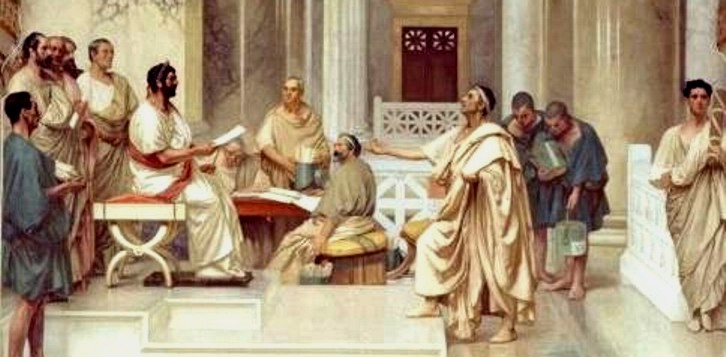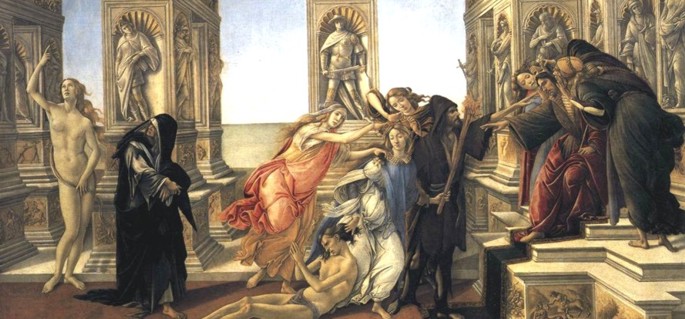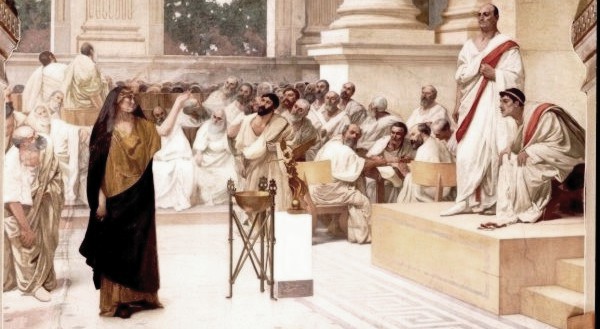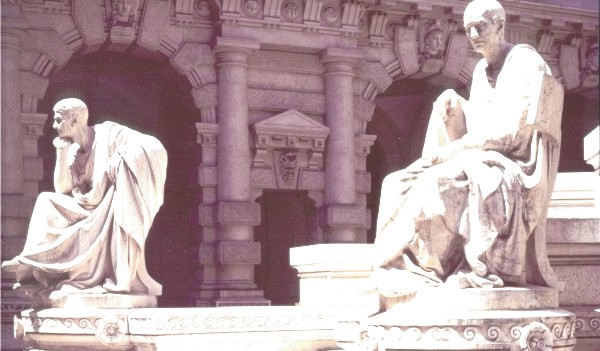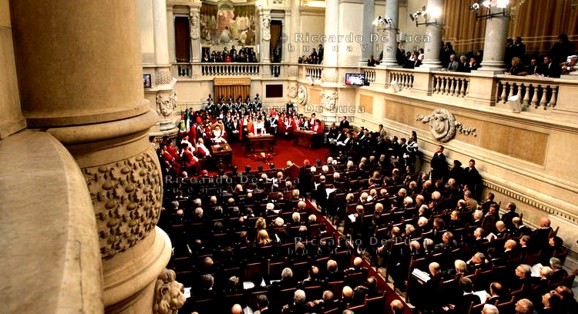
Category: Appeals 2009-2015
Wednesday, July 10, 2013
Appeal Starts 30 Sept: Why This Man Could Stop Defense Dirty Tricks In Their Tracks
Posted by Peter Quennell
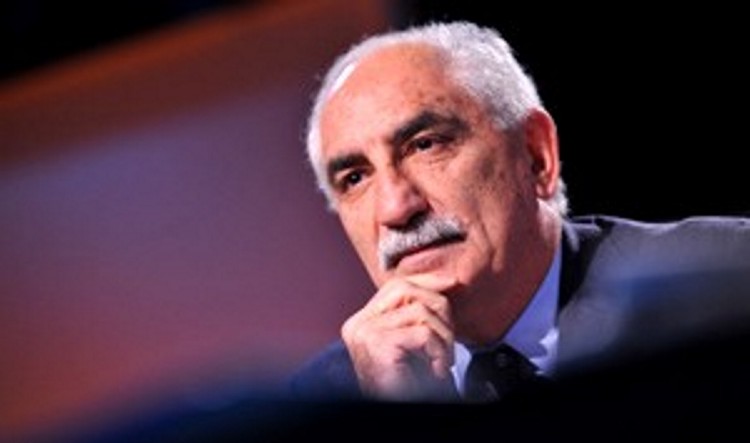
Deputy Chief Prosecutor Armando Spataro.in Milan is one of the toughest prosecutors in Italy.
In September Florence’s current chief prosecutor Giuseppe Quattrocchi will retire - and Dr Spataro is considered to be the frontrunner to take his place.
The Florence prosecution team is being made even more formidably tough these days because it has some very high-profile cases involving national politicians and corruption on its hands.
Read Yummi’s detailed post of 21 January which explains much of this context - and why Florence will be very averse to the dirty tricks the Knox-Sollecito defenses and their allies were able to pull in Perugia.
Florence was the jurisdiction where a rogue prosecutor and a rogue judge sentenced Dr Mignini for what Cassation scathingly declared were fully legal actions, when it recently killed a trumped-up case against him and Dr Michele Giuttari stone dead - and opened the way to Dr Mignini being the next chief prosecutor in Perugia.
Dr Spataro will be especially formidable against Knox and Sollecito and their army of shoot-themselves-in-the-foot defamers because he has stood up to strong Italian government and American government pressures before. Our September 2009 post explained:
Italy’s a tough country with, albeit dwindling now, a legacy of violent crime, and many brave prosecutors over the years have been assassinated.
And the Italian legal system is not particularly weighted in their direction, with a large number of hurdles they have to climb over before a case ever gets to trial.
And the Italian prison system is relatively lenient, heavily pro-prisoner-remediation and early release, and proportionally only 1/10 the size of the US’s.
So the endemic attempts to undermine Prosecutor Mignini have invariably won only MORE popular support for him and his case in Perugia and Italy in general.
And the only “criminal charge” against him (it isn’t) seems to flow from his guessing right in the Monster of Florence case - and apparently no charge of this kind has ever won a “conviction”.
Above is Milan Deputy Chief Prosecutor Armando Spataro. He is in the news now because he has demanded prison sentences for TWENTY-SIX Americans.
Between them they seem to have colluded in grabbing Osama Moustafa Hassan Nasr, an Egyptian in Italy, back in President Bush’s day, and taking him off to be tortured.
Not to the United States where torture is not legal, but to Egypt where it more-or-less is.
Human rights advocates charge that renditions were the CIA’s way to outsource the torture of prisoners to countries where it was practiced.
The CIA has declined to comment on the Italian case, and all the Americans are being tried in absentia and are considered fugitives.
As we remarked in [another] post it is pretty hard for a foreign government and especially now the American government to throw sand in the Italian wheels of justice.
ut
The American government is really just sitting this one out. And it may be covertly delighted when Amanda Knox and her clan fade to silence.
Dr Spataro went on to win that case against the 26. Although their extradition is not yet being pushed,-for, the State Department sided with Italy and gave them no immunity.
State was even sued over that, but good Italy-America relations were deemed important enough to come first.
Wednesday, July 03, 2013
Questions For Sollecito: Did Your Father & Lawyers Pre-Approve This Rant?
Posted by Our Main Posters

[Francesco Sollecito previously on Italian national TV trying to explain the weirdness of his son]
This is in response to your open letter to Italy’s TGCom website.
You are starting to sound eerily like the serial killer Ted Bundy in jubilant “catch me if you can” mode. Ted Bundy also thought he was the brightest guy on the block and the cops, prosecutors and judges were all a few bricks short of a wall.
Ted Bundy was of course caught, by smart cops, and put on trial, by smart prosecutors in front of a smart judge and jury. He made a terrible hash of his defence, he was unanimously found guilty, by a jury of smart peers, and he was made to pay his dues to society and the victims’ families - with his life.
You posted this to an audience in Italy which for the most part thoroughly dislikes you, when you are already in line for sentences that could cost you 30 years ranging up to life.
So. Did your father Francesco and your lawyers Bongiorno and Maori (and all of Knox’s people) give you the go-ahead for this seriously bizarre rant, or not?
Once upon a time, there was Amanda and Raffaele, she was an American student, studying languages and he studying Computer Science. They met at a classical concert and fell in love… no wait like that it is too boring….Lets make it more intriguing, lets see…..I know!
The prosecution found a crazy drunk, and cocaine dealer, Kokomani, after a year the story becomes: Amanda and Raffaele met in August, no one knows how or when, and one day at a bar, where Kokomani would get drunk, Amanda’s uncle came from America, no one knows why or when, and introduces the fiancees ( about to get married, I would say at this point) to the ignorant (unknown) Kokmani (who maybe thought he was going to be the best man) it’s clear. UNDERLINING that he is Amanda’s uncle and the two young people are Amanda and Raffaele (famous at the time, after all)
Mmmm…...come on it’s not the best, but at least it is more interesting, it doesn’t matter that there is no confirmation to none of this, anyway it’s a movie, OK. let’ s continue…..
Raffaele rents a house on Corso Garibaldi, a five minute walk from Via della Pergola, where Amanda lives with three roommates, Meredith, Filomena and Laura. The two pass many days together, they cuddle, have fun, they have outings to towns close to Perugia, and a couple of times they have lunch at Amanda’s house with the other flatmates. They live enthusiastic days, smiling every time they look in each others eyes….. Halloween Day, Oct. 31 2007, Amanda goes to work at Patrick Lumumba’s pub, so Raffaele works on his thesis and late that night they meet up….. to be together as always, taking care of each other.
Uff! What a pain in the ass! Give this movie a bit of adrenaline, what the hell! O.K. O.K…...one day along comes a heroin addicted serial super witness brought by the prosecution who says that he saw Amanda and Raffaele in Piazza Grimana, by a small villa a few feet from via della Pergola, discussing vividly, no one knows what and no one knows what day, but it happened at 9:00p.m. to 11:00p.m. circa. It doesn’t matter that the night between the end of Oct. and beginning of Nov. was freezing cold, it doesn’t matter that Raffaele has a house where he can do what the hell he wants, but according to the heroin addicted serial super witness, the two were under the rain for three hours (if we are talking about Nov. 1, 2007) and the cold discussing who knows what, furthermore, the heroin addicted serial super witness of murders (who’s name is Curatolo) says that when he went back to Piazza Grimana the two contentious fiancees were no longer there and he saw the buses that go to the discos boarding the kids…..it doesn’t matter that the 1st of Nov. there is not a bus in this world because the night at the disco was on the night of Halloween, Oct.31, 2007…...for the Pubblico Ministero Giuliano Mignini, Curatolo was a credible witness. Even because heroin does not produce hallucinations while cannabis does.
In reality the two fiancees passed the evening and the night at Raffaeles’s house since it was free and they had an intensive week of commitments. The 1st of Nov. in particularly Amanda had to work at Patrick’s pub, but as the evening was not busy he did not need Amanda, and after a friend of Raffaele’s passed by to cancel an appointment to go to the bus station, suddenly the two fiancees had the night free and they passed the time watching the movie “il favoloso mondo di Ameliè”, then eating fish Amanda read Harry Potter in German to Raffaele and they made love all night…...
Il Giudice di Primo Grado, Giancarlo Massei took in full the version of the heroin addicted serial super witness tramp….. Come on Giancarlo we are still not satisfied! Come on! These two fiancees are cramming our balls!! You are all of us….
According to the reconstruction of Judge Giancarlo Massei, that sentenced Amanda and Raffaele to 25 and 26 years in prison, things went this way: Amanda and Raffaele after being 3 hours in the cold under the rain, the night of the 1st of November 2007, head toward Amanda’s house in Pergola street and go right away into Amanda’s room (a room that was smaller than Raffaele’s cell when he was in prison) and start making love to bother Meredith who was reading a book in the other room…doesn’t matter that more than 5 people had car trouble and were waiting for a tow-truck, in front of the house during that time, and they give testimony that nobody passed by
Sorry, but why didn’t Amanda and Raffaele go to Raffaele’s house that was free and nobody would have been bothered?.. . Come-on! Why do you have to take into consideration this useless details, show us some firecrackers! Go Giancarlo!
Judge Massei continues: sometime during the evening, while the two were having sex in Amanda’s room, suddenly somebody knocked at the door… Amanda and gets up and gets dressed goes to the door and who does she see? ...Rudy Guede, a colored guy that didn’t know anybody except the guys of the lower floor and had met Amanda and Meredith one time but never in his life had he met Raffaele,. that urgently needed to take a shit.
But what?! What kind of plot is this? Where in the hell do you see that people go around knocking on doors because they need to take a shit?... Come on Giancarlo do not disappoint us! But judge Massei does not disappoint us…. Meanwhile Amanda opens the door to the poor black, victim of bewitched charm for Amanda, and goes inside to go to take a shit…. and Amanda as if nothing happen, goes back in the room and gets undressed again…
But why couldn’t Meredith go open the door while she was reading a book?..Oh, right! Otherwise Amanda loose the part of the main actress, sorry, you are right!
Practically , according to Judge Giancarlo Massei’s reconstruction the story goes on like this : while Amanda and Raffaele went back to have sex, Rudy Guede comes out of the bathroom, after listening to some songs on his ipod, he is overwhelmed by the SEXUAL VIBRATIONS that Amanda and Raffaele were relishing in the house hallway and the house room….
WTF Giancarlo, this is tough shit! Not even Dario Argento could come up with something like that…. “SEXUAL VIBRATIONS”....WTF you are a genius!! Give me five!...but the good part has still to come: when Guedé smells the SEXUAL VIBRATIONS, all of a sudden he is possessed and decides by all means that he has to have sexual intercourse with Meredith.. and ventures in her room and, being rejected, because poor soul he is ugly, Raffaele and Amanda get into the action and at that point dont help Meredith who is their friend, but, to the contrary and unexpectedly, they help Rudy Guede to rape Meredith and than finish her up cutting her throat…
All three had knives: Rudy has a past as thief, he used to burglarize offices and apartments with the same “modus operandi” that he used to get in in via della Pergola, moreover he has been captured while sleeping in a kindergarten in Milano with a knife in his bag. Raffaele had always a little collector knife in his pocket: never mind that he never used it to hurt anybody in his life, there are no traces of anybody else on his little knife “¦.Amanda… and Amanda? Judge Massei says that she used an enormous kitchen knife got from the “looser” Raffaele’s house and put it in her purse…. why?? because…YOU NEVER KNOW (a 15 cm knife can be always useful “¦).. Massei says.
But the poor Meredith was a small build girl, her wounds are not that big and that knife would have gone through the neck because of how big it is… there isn’t blood on that knife nor Meredith’s DNA because the analysis of the scientific police are completely unreliable , not having being compelled to observe the international protocols. There are no bleach traces. What the police says are hypothesis never proved .
Come on, details! But there are no traces of Amanda and Raffaele on the crime scene, there are only Guede’s, everywhere. How it is possible that they were cleaned, were are the traces of the cleaning??! Come on do not break our nuts! This is just details, let me see this movie!
What about that little bra hook? There are 5 different profiles…all on the iron part of the hook, nothing on the tissue: it has been found 46 days after the “polizia scientifica” swept the crime scene, and meanwhile even the police swept the scene with no anti-contamination precautions and put upside down the all apartment. There isn’t Raffaele profile on that hook: if that mix of traces is properly read you can find anybody’s DNA
Do you want to stop with these bothersome things?!! Lets finish to see this movie!! Massei concludes: we don’t know why Amanda and Raffaele choose to kill Meredith, but we have to accept their choice. THE EVIL CHOICE. Probably under the influence, because they didn’t despise her, taking into account that they said that they smoked a joint… unfortunately nobody tested to check if Amanda and Raffaele used heavy drugs or were in the habit of binge drinking. WTF! Great job! You weld The Exorcist and Lethal Weapon!! Giancarlo you are my idol!!!!
Sunday, June 23, 2013
A Summary Of The Cassazione Ruling On Annulment Of The Knox-Sollecito Appeal
Posted by Machiavelli

[Above and below: justice-themed artwork in Cassazione; motifs are used all over the world]
1. Introduction
On June 18, 2013 the Supreme Court of Cassazione issued the official rationale for the sentence of annulment of the Hellmann-Zanetti verdict.
That verdict acquitted Amanda Knox and Raffaele Sollecito on the charge of murder and sexual violence, while finding Knox guilty of the crime of calunnia (obstruction of justice by maliciously placing false accusation against a person you know is innocent).
Previously I posted here a summary of the recourse to the Cassazione by the Umbria Prosecutor-General Dr. Galati and Prosecutor Dr. Costagliola which demanded an annulment of the appeal verdict. I also posted here a first summary report, from the March 25-26 Supreme Court hearing, when the Hellmann verdict was annulled and thus prosecution recourse was won.
The 74-page motivation report states clearly that Cassazione “accept the points of the recourse” from both the Prosecution and the Kercher parties, while they reject the Knox defense recourse.
While you will realize it yourself in reading it, I can say in advance that what the Supreme Court points out in the appeal verdict is a pattern of manifest violation of an unprecedented gravity. All those I know in the law professions have never seen, throughout their professional lives, a Cassazione bashing portraying such a concentration of flaws in one verdict.
Mostly written by Judge M. S Caprioglio (possibly including parts by Judge Severo Chieffi) the document features a sophisticated Italian language and a formal style.
The first half of the report is a summary of judicial events and arguments made by the parties through the previous instances. The second part basically dismantles all the points of reasoning of the Hellmann-Zanetti verdict, without spending too many words for each one of them.
2. A premise about the concept of legitimacy judgment
The second part is introduced by an explanation about what a “legitimacy judgment” is, about its scope and boundaries. The Court is called to assess 1) whether the judges of merit indicated reasons for their decisions, and 2) if reasons are logically argued and legally founded.
The meaning of “logically argued” is that the Court shall verify that the lower judge actually did take into consideration the evidence included in the trial file (“principle of completeness”), and if reasoning is consistent with them, and with the law. The Court “being a “court of legitimacy” [decides on legitimacy of the process that lead to conclusions, not on the merit] “does not assess directly the existence or the quality of the pieces of evidence, but may well assess the quality of reasoning about it and its actual consistence with the evidence in the file”.
So the legitimacy judges staying within their boundaries are not prevented from assessing whether the lower court followed logical criteria, meaning assessing if arguments used by the lower courts are plausible, as well as if their reasoning is “complete” and truthful with respect to the evidence file. The Supreme Court is also allowed to access the evidence trial documents for the parts that may conflict with the verdict conclusions.
The Court states that the present case is obviously based on circumstantial evidence, but points out how circumstantial evidence is not less powerful or logically less valuable than direct evidence.
While remaining within the boundaries of the legitimacy judgment, the Court notes anyway that at first sight in the Hellmann-Zanetti verdict there is an obvious “parceling out” of the pieces of circumstantial evidence. This means a lack of assessment also of each piece of circumstantial evidence, since the judge failed to check whether the possible flaws and lacks in the logical value of each single piece of evidence could be filled by crossing them and taking in account the whole set of them.
The Court also notes however that the judges’ conclusions also openly contradicted some of the pieces of evidence: they neglected or “overlooked” them in some cases, or dismissed some pieces on which the previous reasoning was based without offering adequate reasons. Moreover the pieces of evidence were also not “adequately elaborated”, and the pieces of reasoning about them were “not coordinated”.
3. The Amanda Knox calunnia
Reversing the order of topics from the Galati-Costagliola recourse, the Court deals first with the charge of calunnia for which Knox was convicted twice [obstructing justice by accusing a person who you know is innocent] (p. 41-44), since on this topic there is a converging of all recourses and unanimity by all judges. The appeal court had dismissed a possible link between the calunnia and the murder charges, but the explanation provided for that appears obviously illogical.
The Hellmann-Zanetti scenario - by which, they say, Knox may have voluntarily accused an innocent man just because she was pressed by investigators, thus for a purpose totally independent from the intent of obstructing the investigation on the charge of murder “is argued in a way that conflicts with and neglects the actual evidence documents”.
While Hellmann-Zanetti argue solely based on a police interrogation scenario as if the false accusation was an event confined within it, the Cassazione does not see Knox’s calunnia as a single event nor as a behavior limited to the situation of the interrogation, but rather as a prolonged behavior extending over a time of many hours and days (“perduranza in atteggiamento delittuoso”). Basically Knox goes on implicating Lumumba repeatedly, and she repeatedly provides false evidence, such as through her hand-written note “where she stands by what she declared” and by her subsequent behavior.
The Court also observes the evidence file contains evidence that was overlooked by Hellmann-Zanetti indicating Knox was aware that Lumumba was innocent, such as the recording of prison dialogues with her mother, where she says she feels guilty for having accused Patrick “a feeling of guilt implies an assumption that he was innocent”.
So the appeal court made mistakes because they lacked inference from pieces of evidence, mainly neglecting to argue elements like the discussion with her mother, her written memoir including the repetition of pieces of false testimony and her court admissions that she wrote her memoir voluntarily.
It points out (p.42) that Knox albeit young was a “mature” person meaning she had an adequate cultural level and education and would be able to regain control of herself afterward even if she had suffered a coercion or a moment of emotional breakdown. Knox would be basically able to understand the gravity of her declaration over a period of time.
If only one single event, such a false accusation caused by pressure, breakdown and stress could have been argued “in the abstract” in the way Hellmann-Zanetti did, considering the calunnia as a choice resulting from an episode of emotional breakdown, but the Hellmann-Zanetti reasoning neglects the actual documents and is not fit to explain the persisting and repeated false testimony.
The Supreme Court reminds that “information about commission of a crime” can be derived also from the interrogation of a police suspect, even from information released by a suspect who had not be read their rights under Art. 64, even from statements that are not usable for lack of defensive rights, and even that in the event the interrogation is to be nullified.
In all these cases the suspect commits a calunnia whenever he/she voluntarily and falsely accuses someone to defend himself/herself (so there can’t be any consequential link between the legal status of the interrogation, and the charge of calunnia or the collecting of information about a crime).
The Cassazione also points out that the Hellmann Zanetti rationale is illogical when it states that “the easiest way out” for one guilty “would have been to accuse the real author of the crime”. The inference obviously does not consider that she may be herself among the real authors of the crime (especially since she lived there and had access to the scene of crime).
The Court also points out the failure to properly address the importance of the details contained in the Knox false testimony (the detailing of this is in subsequent chapter).
4. The crime scene staging
The Cassazione accepts the Prosecution General point of recourse complaining about the failure to consider the evidence of staging a burglary, and says the recourse is “founded”. The pieces of physical evidence suggesting a staging are not satisfactorily argued or refuted by Hellmann-Zanetti.
The Hellmann-Zanetti appeal court also argued in favor of the “lone perpetrator scenario” by introducing some assertions which are unacceptable since they openly “collide” with the trial documents or are unfounded. Basically their reasoning was hinging on elements such as speculations about Guede’s personality, they introduced allegations like a purported habitual burglar profile, not backed by any evidence.
On the other hand they bring in arguments “like that about a glass shard in Meredith’s room” which have zero implications in their scenario (because they are equally good to argue in favor of a staging).
They should have argued “in favor or against” about evidence of burglary/staging based on the assessment of the pieces of physical evidence found on the scene, like argue against Massei’s reasoning about the ones mentioned in the first trial, say why it was not good. On the other hand the break-in scenario, as described by Hellmann-Zanetti, is affected by “multiple logical ruptures”, details are not explained consistently.
Moreover the Court says a scenario involving the issue of burglary/staging should be argued based on the overall evidence about Rudy Guede, meaning a scenario involving the whole of what he had done, like explain all the traces that show his movements, for example the trail of bloody shoe prints showing that he left the murder room straight away.
There are aspects of the reasoning that are “tautological” (circular and begging the question).
The Hellmann-Zanetti reasoning on the same point is also neglectful of part of the file sources (is based on a “partial access to information”), for example it overlook testimonies concerning wounds on Guede’s hands, dismissal of glass on top of items. To sum up, the rationale employs inadequate inferential principles and incorrect information.
5. Man in the park Curatolo’s testimony
Hellmann-Zanetti had dismissed the testimony of Antonio Curatolo.
Their statement about the reliability of Curatolo is totally “censurable”, since it is “apodictic” [assumed as a premise “true in advance” without explanation], and not based on thorough analysis of the data. In particular when they state that he tends to confuse days dates: such assertions are both unfounded and illogical since conflicting with the testimonies of himself and of others witnesses. The Court does not assess the reliability of Curatolo as a witness, but notes that the reasons brought by Hellmann-Zanetti are unacceptable.
The possibility to explain elements of the testimony by mistake of date by the witness, so placing his testimony possibly on Oct 31. is conflicting with the other evidence, namely the testimonies showing the defendants were elsewhere on the 31st. Moreover the elements used for the argument are logically weak compared to the strength of the elements showing Curatolo correctly “anchoring” his testimony to real events.
Then the lower court introduced “as further basis of reasoning” assertions in order to “jump” across the whole of Curatolo’s testimony: they based their conclusion on the asserted “decaying intellectual faculties”, on his use of heroin, and on his modus vivendi.
However they do not offer any element of evidence about the alleged mental decay, they fail to show this through analysis of his testimony, and in fact they completely fail to analyze the actual content and consistence of his testimony (lack of “completeness”). The use of heroin and his modus vivendi (as a “bum”) is also not acceptable as a reason for dismissing reliability of a witness, this would be an arbitrary judgment that violates the principles of witness assessment.
Since the witness was very assertive, consistent and felt certain about his testimony, the court would need a logically strong argument “based on some other finding or certainty” in order to dismiss his reliability (dislikes about his lifestyle or disproven speculations about date mistakes are not).
6. Shopkeeper Quintavalle’s testimony
The Court pretty quickly dismisses the Hellmann-Zanetti conclusions about Quintavalle, on grounds that they are based on a “cherry picking” and twisting of information from the documents, basically they misinterpret and neglect to consider the actual content of the Quintavalle’s testimony.
In fact the summary description of Quintavalle’s testimony that was offered by Hellmann-Zanetti is basically a misrepresentation based on incomplete parts of the testimony and overlooking of others, and flatly contradicts the content of actual testimony (it is not what Quintavalle and witnesses actually said).
It is not true that Quintavalle remembered about recognizing Knox one year later, documents show that he was sure about her identity from the early investigation - the Cassazione quotes some of Quintavalle’s statements where he remarks her circumstances and features.
Hellmann-Zanetti reported some bits of information in a fragmentary fashion without taking into account the explanations of Quintavalle and the answers he actually had given through the investigation.
The appeal court should have analyzed the whole of what the witness actually said, and crossed the statements with the existing information, instead of selecting cherry- picked bits and pinned on them a meaning out of context.
The Cassazione is not interested in assessing the reliability of the witness Quintavalle, but they find “intolerable” that Hellmann-Zanetti give a false picture of the testimony, in a way disjointed from the true content of the trial documentation.
7. The failure to consider implications of Knox’s memoir
The Prosecutor General was right in blaming the Hellmann-Zanetti court for neglecting to evaluate the hand written note written by Amanda Knox as a piece of circumstantial evidence. The appeal court dismissed the memoir as useless on the sole basis that it does not have a substantial meaning (actually: that it did not represent the truth).
But this argument is insufficient (and circular); it is also “structurally” inconsistent because the same Hellmann-Zanetti court used the very same note as a piece of evidence in the calunnia charge, and cannot be logically linked to pressure because she wrote it alone on her own initiative and not during an interrogation.
The Court details the content of the note pointing out that in the hand written memoir there is a repetition of some of the details from her previous “spontaneous statements”, which are now only set in an oneiric [dream-like, surreal] frame (they “seem unreal”) but yet they are the same peculiar details from the false accusation.
The Court also highlights the new “sibylline” [ambiguous and threatening] accusation by Knox against Sollecito (remembering blood on his hands, but probably from fish).
The next appeal court will need to build some actual arguments to explain these features, taking in account that “as for Hellmann-Zanetti” she wrote that while she was fully capable to understand and without any pressure from authorities.
The contradictory nature of the appeal court reasons on this point is “obvious”.
8. Failure to consider judicial files from Guede’s definitive sentencing
The Court spends a bit more than one page to explain why the prosecution recourse is correct in their complaint on this point as well. In fact Hellmann-Zanetti did accept the Guede verdict as a piece of circumstantial evidence, but argued that that piece was “particularly weak”.
However, the problem is that in reality they did not assess it at all in order to come to that conclusion, but they rather just completely ignored the whole content of the Guede verdict reports.
The court is not authorized to dismiss a piece of evidence which they formally entered without assessing it, just on “in limine” reasons. Therefore the decision openly “violates the law” (p. 55).
The Rudi Guede verdict motivations theoretically might be found “particularly weak” as a piece of circumstantial evidence, but it can’t be ruled “particularly weak” on the reasons declared by Hellmann-Zanetti.
The appeal court did not try to argue the logical passages of the Guede verdict in order to assess it and explain why conclusions were weak, instead they decided to ignore it, not based on the analysis of its content but instead based on the legal nature of the document. This is a patent violation of the law, and a conflict with the trial documents.
Thereafter the Hellmann-Zanetti court steered the discourse onto the alleged “habitual criminal” profile of Guede (an interpretation based on speculation) without explaining the reasons for building a scenario about Guede so far-fetched compared to the findings in the trial’s files about Guede.
Moreover the appeal court adds a further, false and illogical argument when they state that, even if Guede was proven to be guilty of concurring with others, this does not have implications for Knox and Sollecito at all because those accomplices could have been other people. The alleged lack of implication is false under logic, because determining that Guede acted together with others would additional information on the crime, which could be crossed with other information (such as about who had access to the apartment etc.).
The Court also remarks that the trials had found and explicitly declared Guede innocent of the crime of burglary, and the appeal court also fails to deal with this in their alternative scenario.
The appeal court also failed to consider other information from the findings of the Guede trial, and explicitly contradicted it without justification, for example they neglected to consider how the courts had determined through multiple witnesses that Guede actually did not have any injury on his hands on the night after the murder [Guede had cuts on his hand, but many days later, not the night after the murder].
9. Declarations of Rudy Guede at the Knox-Sollecito appeal
There is an open violation of the law in the Hellmann-Zanetti motivations, in the particular statement where they assert that Guede’s declarations in the courtroom were unreliable for the reason that he refused to undergo a questioning.
The reason brought by Hellmann-Zanetti to rule unreliability is illegitimate when referring to the specific declarations of Rudy Guede in the Knox-Sollecito appeal, and legally not true.
First, the Cassazione notes that the decision to refuse a questioning pertaining to a crime is within the rights of a witness who is implicated in the same crime. If the witness decided to invoke this right, the courts and the parties are bond to enforce it and limit their questions within topics unrelated to the crime, and under the law, no conclusion about reliability/unreliability can be drawn solely from the witness’s decision to refuse to answer about a topic in which he was implicated as a defendant.
No court could conclude that a witness is unreliable on the sole ground that he enforces his rights.
Moreover, preventing an interrogation of the witness on such topics is just a duty of the Prosecution and the Court, not a ruling “in favor” of the witness (and co-defendant).
The Prosecutor General had summoned Guede to testify only about the topic of things he said during conversation with inmates and letters he wrote from prison, and since the witness invoked his right as an ex co-defendant the Prosecutor General had the duty to enforce the limitations on his questioning.
It was the Sollecito-Knox defence attorneys who attempted to place questions directly on the topic of the events of Nov. 2, 2007, and they asked Guede to confirm the content of his letter directly pertaining the Kercher murder. The defence asked him to confirm if one particular statement of the letter he wrote was true, and the statement of Rudy Guede confirming his Knox and Sollecito implication and accusing them of murder was only in response to this, stemming from the defence question.
The declaration of Rudy Guede might be considered irrelevant as a piece of circumstantial evidence; and the witness might be assessed as unreliable by a court, but this cannot be done based on the illegitimate grounds brought by Hellmann-Zanetti. You cannot have, as an argument for unreliability, the fact that Rudy Guede chose the legal option of not undergoing a questioning about the murder.
The Cassazione also notes how the Hellmann-Zanetti report details some of Guede’s declarations in order to argue for his unreliability. However the cited statements from the Skype conversation with Giacomo Benedetti are used by Hellmann-Zanetti just to build an illogical argument: they say Rudy should have logically indicated the true culprits in that call, the fact that he does not accuse them is an indication that they were not there.
This argument is flawed (besides contradicting the very same claim about Guede’s unreliability). The Cassazione sees the weakness of reasoning about the Skype call as “symptomatic” of the lack of logical consistence of the appeal court on the topic of Rudy reliability, and it also reveals that the criteria they are following are not compatible with logic.
The appeal reasoning is also contradictory on further points, as Hellmann-Zanetti consider some declarations of Guede “reliable” without logical reason - like about the timing of death, where the appeal court considers Rudy’s statement reliable without considering that he had an obvious logical interest and an attitude of misleading the accusations by providing details that were conflicting with evidence.
Paradoxically, had the Hellmann-Zanetti court followed the same criteria on other declarations, they should have considered Guede’s declarations “reliable” when he says “Amanda is not implicated”, as well as when he says - talking about Sollecito - “I don’t know, I think it’s him” . The appeal court did not follow the principle of completeness and they did not consider these.
The Hellmann-Zanetti report also fails to consider that Guede was assessed as “totally unreliable” by his trial judges (they could have used such finding in documents to argue unreliability of his statements instead; if they had only read the Guede verdict). In other words they worked inconsistent arguments out of on an incomplete set of data.
10. The refusal to listen to the whole testimony of witness Luciano Aviello
The appeal trial was procedurally flawed also by the refused to call Luciano Aviello before the court again, as he was supposed to complete what was left out of his testimony.
Luciano Aviello was called as a witness by the court in accepting a defence request; after his hearing, during the course of the trial, new elements emerged “new witness declarations” that created a necessity to put some further questions to the witness.
The Hellmann-Zanetti court refuse to call back the witness to complete the questioning, despite that he had already been accepted as a witness by the same court. So the witness was basically prevented from completing his testimony.
The Cassazione does not argue about the reliability of Aviello as a witness (nor about the relevance of his testimony) but points the finger against the inconsistency of Hellmann-Zanetti’s ruling, which causes their decision to be illegitimate.
The refusal to call back the witness to complete his testimony at a second hearing was manifestly inconsistent, since that violates the principle of completeness (once you call a witness, you need to be ready to listen to all that he has to say).
The court’s decision was “unacceptable” (p. 58) also because it was based on arbitrary criteria - as Hellmann-Zanetti said “another hearing of the witness is not indispensable” on the ground that minutes of his interrogation were entered in the file: the decision violates the principles of usability of documents and the rules of witness hearing.
The appeal court completely ignored the reasons for and the new content of the topics Aviello was to be questioned about, and did not assess them. Instead, they violated articles 511, 511bis and 512 of the procedure code by “replacing” it with non-usable minutes of his interrogation.
The judgement of “non-indispensable” was also unfounded, manifestly so compared to the importance of the topic which referred to the explanation and completeness of Aviello’s testimony. A plot concerning a secret agreement in order to offer false declarations in court is obviously a topic with some relevance.
There is also a violation of the principle of confrontation, because Aviello was a defence witness and the Prosecutor General had the duty of carrying on an assessment of the witness within the appeal trial by cross examination (Hellmann-Zanetti’s decision allowed only the piece of testimony that could be favorable to the defence, and they cut off the part that could be unfavorable).
The motivation is also incomplete as Aviello is ruled “unreliable” a priori because of his retraction (which Hellmann-Zanetti apparently considered reliable) and irrelevant as a piece of evidence without actually listening to the content of his testimony, to what he had to say.
The testimony of Aviello could not be “cut off” that way and could not be considered unreliable a priori without listening to it.
11. The re-framing of the time of death
The Court devotes four pages to explaining how Hellmann-Zanetti’s reasoning about re-location of the time of death is illogical.
The appeal court refused to anchor the timing (and further features, noises etc.) of the screaming, to the time frame offered by two witnesses, Nara Capezzali and Antonella Monacchia. They also dismissed the testimony of Mrs. Dramis. Instead they accepted the defence idea of determining the time of death based on the statements by the “unreliable” Rudy Guede. They put the time of death in relation to the phone calls, around 9pm.
As for the Cassazione, such an argumentation path is woven through with “conjecture and illusions” (p. 61). The bases chosen for inference are devoid of any factual validity, as opposed to the elements of evidence which were discharged, which are instead extremely relevant.
The Hellmann-Zanetti report refutes the elements (testimonies of Capezzali, Damis, Monacchia) with arguments which are riddled with obvious, multiple inconsistencies [like the claim that a half-an-hour error would make the testimony unreliable, or that Nara’s looking unsure between the dates of Nov. 1. or 2. makes the scream attributable to something else, as if she was used to hearing blood-curdling screams every other day and as if the Monacchia confirmation testimony didn’t exist].
So the Hellmann-Zanetti rationale dismisses as “unreliable” or “useless” some very relevant and consistent testimonies (from witnesses they declare “credible”), while on the other hand, it accepts as “reliable” a dictum by Rudi Guede and builds a theory of the time of death on it - despite the defence itself having pointed out how Guede was totally unreliable and was also very able at changing and twisting every detail of his story, all the time and on any occasion, from the earliest stages of the investigation.
The Cassazione states - without any possibility of question - that it is manifestly obvious that things Guede consciously stated on the Skype conversation could never be used as the main credible source to build an inference about the time of death.
Moreover the Court points out that in fact the appeal court cherry picked just one statement by Guede, regarding the time of death, and considered it “credible”, while neglecting to note how within the same Skype conversation Guede also made a number of assertions about Knox
These included statements that place evidence against Knox and Sollecito. While in the same conversation Guede says “Amanda was not implicated”, he also states that Amanda was in the house; he states remembering that in Romanelli’s room the window appeared intact, and denied having broken it, he inferred that Knox and Sollecito must have done it; he also assumed that they must have altered the scene of the crime and the victim’s body; he also said he thought the man he saw was probably Sollecito.
The Hellmann-Zanetti court simply neglects to consider and deal with the whole information from the Skype call, which they instead elect to reliably source solely regarding Guede’s declaration about the time; so “besides illogicality in the unfounded dismissal of other testimonies” their method of processing information violates completeness and consistency.
The appeal court is also extremely weak where they try to fill the logical gap by drawing further inference from Meredith’s phone records. The attempt to link a mistaken phone call with the time of death is simply inherently implausible, a wrong call is a trivial event and there is no reason to make such link; also the delay by Meredith who did not call her mother again within the next half an hour is a trivial element which doesn’t have a specific implication upon the time of death.
The worst Hellmann-Zanetti did on this topic is the downplaying and underestimation of the testimonies of the three witnesses - Capezzali, Monacchia and Dramis.
In fact Capezzali described the scream in detail, picturing it with a number of features - “harrowing”, “unusual”, “long”, “isolated” and stressed its uniqueness and added additional information about noises (gravel path etc.) unequivocally linked to the cottage, she made clear that she never heard something similar before.
Monacchia was even more precise about the timing, since she went to sleep at 10.00 pm and slept for a while; Dramis came home back from the cinema at 10:30 pm. Their timings converge in placing the timing of an isolated scream later than 10:30 pm.
On the basis of Nara Capezzali’s testimony, it is absolutely unreasonable for the appeal court to assume that Nara could confuse the scream with the usual other “noises” of “junkies”.
Dramis as well referred to having been awaken by some noise of a kind she never heard before. Hellmann-Zanetti ruled out the time frame offered by the testimonies of Monacchia and Dramis for no reason except that they gave their testimony one year later; this is a totally insufficient and illogical reason.
As for considering Rudy as a reliable source, instead it is acknowledged that Guede was obviously lying and following a pattern of behavior/strategy of providing a flow of false details to muddle investigation.
The Court adds that neglecting the importance of information about the scream seems even more stunning when you consider the fact that the scream coincides with a detail that was mentioned in an early testimony of Knox [and even in declarations of Guede].
12. The court appointing of new experts and their management
This point may be the most interesting because it is the only topic on which the Supreme Court doesn’t agree entirely with the Prosecution General.
The Prosecution’s complaint was “˜partly’ correct about objecting to the legitimacy of the appeal court appointing new experts.
The point of recourse is founded insofar as the appointing was insufficiently motivated in the rationale: the reason expressed ““ basically addressing just the judge’s lack of scientific knowledge ““ is inconsistent, and also inadmissible because it violates the principle of non-delegation of judgment.
However, the judge’s decision of appointing experts itself should supposedly always be based on assessments of the merits of the evidence. The Cassazione cannot decide on the merits, so the decision about whether more expertise is necessary or not, which was supposedly taken based on the evidence available, is an exclusive competence of the judge of merit and the High Court can’t discuss it.
The absence of consistent motivations for the appointing reveals an insecurity of the appeal court about the evidence, which they (rightly or wrongly) attributed to incomplete information. However, the peculiar way the appeal court subsequently managed the experts is censurable.
The experts decided to not test the new DNA sample, despite the fact that the amount was 120 picograms [so much more than “˜5 picograms’ as declared by Vecchiotti in court, ed.], on an arbitrary decision by only one of the experts, on the ground that it was a “˜Low Copy Number’. Such a decision ““ itself unlawful ““ was subsequently subscribed to by the appeal court.
When the Prosecution General and consultant Prof. Novelli requested to go on testing the sample, since it was perfectly possible to do so, the court denied, arguing on the false assumption obtained by misquoting Novelli as saying the required techniques were “in the experimental phase”.
This was a misquote, a misinterpretation of a statement by Novelli, and the Court finds it to be false in the documentation: Hellmann-Zanetti incurred a gross misrepresentation of reality as they called the new technology “experimental” and “unreliable”.
Beside this false claim, it was on principle unacceptable that the expert Carla Vecchiotti refused to carry out a test, and that the judge accepted such a decision.
The expert’s decision violated the judge’s previous ordnance, because the written order said that they must require the court’s opinion before taking any decision, not after; the judge’s change also violated their own ordnance, because it withdrew from the previous tasking.
The modus operandi of the court therefore was to let an expert make decisions about their own mandate, based on their own judgment about the subsequent value of their finding in court.
But the experts had no authority to reduce or re-frame their own mandate, it is not up to them to preemptively decide whether their finding is reliable or not and anyway they cannot refuse to accomplish an order or to bring a finding into court; no matter if their finding is unreliable as a piece of evidence, they have to bring it anyway to court discussion, and its value will be determined through court discussion.
Hellmann-Zanetti were incomplete on documenting Novelli’s positions which were expressed during the experts’ testing and are in conflict with the Vecchioti-Conti decisions. They could have chosen Vecchiotti’s positions, but only after having dealt with the arguments expressed by the other side too.
The decisions by which Hellmann-Zanetti managed the experts’ work is also in violation of the principle of equality and the right of all parties to bring evidence, since they ordered a perizia [experts investigation] but then they prevented it from being fully accomplished: they only allowed the research activity by which the defence was seeking evidence, while they prohibited those activities requested by the accusation parties.
Once they ordered new scientific tests, the order should have been completed without any a priori unjustified preclusion. Their unbalanced modus operandi was an alteration of the evidence information set, and a violation of the law (p.66), and cause their motivations to be manifestly illogical.
13. The DNA evidence
The appeal court passively accepted the new experts’ conclusions, while ignoring the opinions of the witnesses Novelli and Torricelli. Their arguments had a comparable degree of importance, and the witnesses had at least the same degree of expertise and authority than the judge appointed experts.
As the judges chose to believe the conclusions of some experts in disagreement with others, they are not obligated to demonstrate themselves that such conclusions are true, but nonetheless they are required to report the arguments made by the other side and they need to deal with them in a reasoning.
This is especially necessary if the expert witnesses have a great expertise and credibility, at least comparable to that of the judge-appointed experts.
Hellmann-Zanetti accepted the C&V report entirely and passively, without confronting it with the opposite arguments and objections. Such procedure is illegitimate, since objections and arguments were not even mentioned.
The Casssazione recalls, among the not-mentioned and not-dealt-with arguments, that Prof. Novelli had calculated a probability of misinterpretation of the alleles on the bra-clasp; and Dr. Torricelli analyzed the Y-haplotype on 17 loci and found no match except Sollecito.
Novelli also testified that recommendations and protocols do exist, but the operator’s competence and common sense in scientific assessment is more important. He also said that the researcher should be always allowed to depart from standard procedures when single situations suggest so.
The judge-appointed experts themselves ruled out laboratory contamination. Novelli analyzed the series of samples from all 255 items processed and found not a single instance of contamination, and ruled out as implausible that a contaminating agent could have been present just on one single result.
Also Dr. Stefanoni testified that the knife was tested 6 days after an alleged contaminating and Vecchiotti confirmed that the time interval would lead to rule out laboratory contamination.
Hellmann-Zanetti also ignored or twisted information regarding the crime; it ignored the finding that no instance of Sollecito’s DNA was found on the scene as a possible contamination source despite may environmental samples; the High Court labels as false ““ going by the evidence file - Hellmann Zanetti’s statement saying that “everybody had walked around into the house”.
Also Cassazione notes that deterioration of an evidence scene due to time would normally cause a loss of DNA information, not an appearing of new information not found elsewhere.
So Hellmann-Zanetti did not take in account nor cite a huge part of the credited opinions and information; the total failure to mention such a major chunk of information by Hellmann-Zanetti makes their judgment about the topic illegitimate, and shows their “˜unacceptable’ modus operandi.
However the most surprising point of Hellmann-Zanetti ““ in the Cassazione’s view ““ is their uncritical accepting of the theory that contamination is “possible”, without linking the scenario of likeliness of contamination to any factual finding or datum. They actually built an axiom on a straining, a cherry picking and a falsifying of information.
The Court also reminds how Novelli testified that, in order to have a plausible scenario of contamination, you need to prove the existence of a source, of a vehicle of it.
They note from the documentation that negative control did exist, and that Vecchiotti & Conti were “˜superficial’ in assuming they did not exist just because they were not included in the technical report.
The Supreme Court then points out that:
(1) the collection of items was performed correctly contrarily to Hellmann’s suggestions, all activities of collection and laboratory tests were done before the eyes of defence experts, the environments were not contaminated, and the defence experts that were assisting did not raise any objection, they complained about things only much later;
(2) the arguments and explanations dr. Stefanoni subsequently gave were not adequately refuted;
(3) the picture of correctness in procedure causes the burden of proof in order to claim likeliness of contamination to rest squarely on the shoulders of those who claim it.
The law does not admit to set out the reasoning from a sheer “falsification” paradigm (meaning: it is wrong to assume that the prosecution has any burden to demonstrate the absence of contamination). Such an assumption would make it impossible to collect any piece of circumstantial evidence or do any scientific test at all.
The argument that the evidence should be dismissed as unreliable because contamination is “˜possible’ is totally illogical. You can’t dismiss pieces of evidence on the ground of a mere “˜possibility’ (or we should dismiss all pieces of evidence collected on all cases).
An alleged contamination event needs not to be only “˜possible’ (everything is possible), it needs to be “˜credible’. In order to consider if contamination was likely on a specific instance, some factual evidence of the specific causal circumstance is needed.
To bring a claim about “˜contamination’, while you don’t need to actually prove that the event of contamination occurred, you do need to prove a factual and scientific datum that would cause that specific contamination event to be “˜credible’ (probable).
In order to claim a contamination likely occurred, pointing at issues about professionalism of forensics is not enough. The factual existence of a specific “˜vehicle’ of contamination needs to be proven [like presence of a source, evidence of contamination in other results, explanation of the dynamic etc.].
To refute the scientific finding you need something much logically stronger than a complaint referring to ideal practice and protocols and the absolute generic concept of “˜possible’. The claim about a fact such as a specific instance of contamination requires “˜factual’ circumstances and data, “˜specific’ and “˜real’.
14. Analysis of prints and other traces
The objections by the Prosecution General on this topic are correct. The appeal court motivations manifestly lacks logical rigor in multiple instances.
The Court cannot object about the attribution of the bathmat print since the topic is strictly in the merit. But the implied scenario where Guede’s left shoe comes off after he walked on the pillow is implausible: it doesn’t explain why an Adidas shoe would come off, and it doesn’t reconcile with the evidence documentation.
Guede using the small bathroom to wash himself, and then locking Meredith’s door, is in conflict with the trail of shoeprints only showing him walking straight out. It makes no sense to assume that he lost a shoe just because there are blood prints of the right shoe alone.
About the luminol foot prints, it is implausible to assume that those prints were left on some other occasion, since ““ in the Court’s view - luminol basically indicates blood (and in no other circumstance could someone produce such a set of prints in blood). The Cassazione notes that the Massei scenario to explain the footprints was far more plausible, and Hellmann-Zanetti bring no reason to refute it.
The scenario described by the first instance trial court was also more complete, since it was able to connect the dots on several other details, including the “˜mixed traces’ of blood in the small bathroom, on the light switch, etc.
The only argument brought by Hellmann-Zanetti was the absence of Sollecito’s DNA from the blood/luminol stains. For the rest it was an “apodictic” assumption, so that they did not deal with the logical points that were made on the first instance.
15. The declarations of Ms. Knox
The Hellmann-Zanetti verdict was “˜critically’ flawed, as claimed by the Prosecution General, also on this point. This topic area falls into the big picture of parceling out of the pieces of evidence which was done by the appeal court.
The Supreme Court notes that Hellmann-Zanetti just assumed that there was no circumstantial evidence in Knox’s declarations, but they falsely implied that it was about behavioral and emotional evidence. Instead it was about Knox’s revealing a knowledge of details from the crime scene.
The Court mentions some of Knox’s statements conflicting with evidence and testimonies: she told Meredith’s friend of having found the body, she said it was before “˜a closet’, that it was covered, that Meredith had her throat cut and that she suffered a great blood loss. The first degree court reports Knox saying she didn’t see into the room, that she was far away in the corridor when it was opened.
Hellmann-Zanetti fail to mention this set of elements or clues, and they also neglect to consider the issue of Amanda’s phone call to her mother in the middle of the night and subsequent calls.
The Cassazione observes that Knox was unable to “˜remember’ the 12:47 phone call and did not explain its content; but Hellmann-Zanetti mistakenly considered such a phone call as occurring “˜at the same time’ of Sollecito’s calls to her sister and to the Carabinieri. In fact ““ the Court notes ““ Knox called her mother three minutes before Sollecito called his sister, she was first person to make any phone calls.
So Knox’s “˜downplaying’ of her phone call ““ her suggesting a total vague content, a sense of confusion and nothing important ““ and the early time of it, are not considered details worth of mention by the Hellmann-Zanetti court, and they are not put in relation to Knox’s inside knowledge about details of the crime (if she didn’t know anything at all, why does she call her mother to express vague confusion, worried about something she doesn’t know?).
What the Court finds objectionable is that Hellmann-Zanetti simply made assertions and steered on, talking about the subjective emotional reactions, without confronting any logical argumentation made by the lower court, and they failed to do anything to demolish the first instance reasoning.
16. Final indications
The Hellmann-Zanetti verdicts are annulled. The new appeal court will have to fix all the critical legitimacy flaws pointed out following the Cassazione indications.
The new appeal Judges will have to assess the pieces of circumstantial evidence in a global an unitary way, to assess whether the relative ambiguity of each piece of evidence can be overcome by the overall system between them.
The result of such an assessment will have to lead to a decision not only about the presence of Knox and Sollecito on the murder scene, but also about their possible roles in the crime, and to decide among an array of possible scenarios: from a premeditated intent to kill to possible scenarios that may involve a non-premeditated decision to murder as a departure from an original plan to have a non-consensual sex game, or involve a forced sex game that run out of control, or a similar situation.
The recourse submitted by Knox on the point of her conviction for calunnia is rejected. All points of recourse 1-10 by the Prosecution General are accepted, the appeal trial is annulled on grounds of manifest illogicality, inconsistence and violation of law for all conclusions of acquittal; instead, the conviction for the charge of calunnia stands, but the denial of aggravation in finding it not-linked to the murder is annulled.
Knox is condemned to pay the legal expenses sustained by the State and by Lumumba. If found guilty, Knox and Sollecito will have to pay also the expenses sustained by the Kerchers.
17. Considerations arising from the report
My final thoughts. Since the appeal verdicts were annulled, the legal situation is that Knox and Sollecito stand currently convicted in first degree and awaiting the appeal, which they had launched against their convictions.
They had already got a fair trial, before a court presided over by Massei; now they are appealing the verdict in a Florentine court. An appeal ““ under the Italian criminal procedure ““ can take the shape of a new trial ““ usually, partly ““ and so open again sessions where witnesses are heard and evidence are entered.
However, in many cases this doesn’t happen, and the appeal doesn’t look like a full trial. Anyway, even if the trial phase is re-opened, what may look like a trial de novo is in fact only an extension of the previous one; meaning: the trial de novo in fact doesn’t start from scratch, but starts from the documentation already existing and incorporates the previous proceedings.
The main piece of documentation now incorporated is the 2013 Supreme Court verdict.
Whatever appeal court deals with the Knox-Sollecito proceedings, they will have to set it within the guidelines, limitations and indications established by the Cassazione.
The Cassazione has dismantled and declared illegitimate all the procedural points by which Hellmann-Zanetti had come to verdicts of acquittals on the charge of murder. This shows how the appeal judgment was obtained only thanks to a dreadful series of procedure errors.
Unfortunately, actually not all errors in the Hellmann-Zanetti rationale could fall under the radar of the supreme court. The appeal court didn’t make only legitimacy errors, they also committed obvious mistakes in the merit of evidence assessment (and, not even all legitimacy issues were actually brought to the attention of the Supreme Court of Cassazione).
Examples of mistakes in the merits by Hellmann-Zanetti: they attributed the bathmat footprint on two unproven assumptions:
(1) The first was that the person who left it must have got his foot wet with blood by walking on a hard, flat surface smeared with blood; an obviously unfounded assumption, actually proven false since there was no hard flat surface covered in blood where anyone had walked (blood got on the murderers feet from soaked towels).
(2) The second ““ idiotic ““ “˜reason’ was the observation that Sollecito’s toe in the sample print looked more triangular (!) than the bathmat print’s (it is actually obvious that any object would leave a print with slightly more rounded shape on the bathmat compared to the sample paper, since the bathmat is a soft surface).
Another one was the claim that the pattern of footprints in luminol could be found in any apartment and be produced in any innocent situation (in a non-blood substance) but somehow they “˜forgot’ to mention what kind of likely substance that could be, and what plausible dynamic - except shuffling on rags or mat ““ could have produced them.
Flaws in the rationale and procedure are surreal, like maintaining that Knox’s written memoir is not evidence that she lied because its content is false. Or appointing experts to test DNA samples, then refusing to test the sample despite it’s being more than 120 picograms.
Even kids could spot the obvious logical errors on evidence assessment in the Hellmann-Zanetti rationale.
The refrain of factual errors and legitimacy/procedure violations is so serious that I can hardly believe any Magistrate of the Republic can make such errors in good faith.
Despite the sophisticated and formal language, as you may have understood from this summary, the Cassazione arguments are actually very simple. In fact the errors were very clear and obvious from the beginning - to quote PMF poster Popper “even a child would notice them immediately” - that in fact the Supreme Court looks like pointing the finger at a naked emperor.
The present Cassazione ruling does not leave any realistic hope for Knox and Sollecito to be acquitted on appeal. They have a right to appeal under Italian law. Though their appeal, when carried on within the rules and principles of law, looks ““ like most appeals ““ basically desperate.
Their actual chances of being acquitted by a Florentine court look essentially zero, because the court won’t be allowed to employ the key arguments and the path of reasoning followed by Hellmann-Zanetti to come to an acquittal verdict; all these logical tools are illegitimate, and hardly any judge could fix them, nor come to a “˜not guilty’ verdict by following other logical ways.
The only positive legal outcome in realistic terms for Knox and Sollecito now consists in seeking leniency or lesser charges based on claiming minor roles, maybe even by attempting to accuse each other.
Either that or testifying to the truth, seeking mitigating factors like psychological state and age, or showing remorse.
Thursday, June 20, 2013
The Florence Palace Of Justice Where Sollecito And Knox Are Expected To Be Seen In Court Soon
Posted by Peter Quennell
This is a video of a recent light show. The soundtrack leaves something to be desired, but the huge new courthouse looks amazing at night.
We posted previously here on the new Palazzio di Giustizia, which is one of Europe’s largest and most modern. It only came into full operation this year.
It is reported today in UK newspapers that Knox and Sollecito have just been having a meeting in the vicinity of New York, maybe to sort out a common narrative once and for all. Our betting is that each will appear in the Florence court, not least to keep a close eye on the other and to attempt to warm the judges to themselves.
However, their nasty and dishonest books have not made things any easier for them, and have led to a lot of negative reaction in Italy where they have been discussed on TV. It is easy to spot where in many places the two texts conflict, and also where (as demonstrated in the two post below) they also contradict many accepted well-documented facts of the case.
Both books are being considered as substantial new evidence, and the prosecution will ask the appeal court if they can be included in.
Both books are also being investigated, by the chief prosecutors in Florence and Bergamo for separate new felony charges, as they appear to constitute substantial lllegal attempts along with the internet vilification posted by the likes of Preston, Fischer and the Moores, to inflame and mislead public opinion during an ongoing legal process.
The writers have also sought to undermine the officers of the court, by accusing them of serious crimes, again as illustrated in the two posts directly below. Many Italians and Americans with “relevant information” could be called to testify for the prosecution or the defenses. They will probably be asked to explain their own inflammatory campaigns and may face charges of their own. Again, Preston, Fischer and the Moores seem to have painted targets on their backs.
Results of both investigations, together with any new charges against Sollecito, Knox, and their entourages, should be made public well before the new appeal of Meredith’s case gets under way.
If the two are indicted on new charges for the books, as expected, that will mean more to explain, more to try to harmonize upon, more goodwill lost, and more legal bills.
If their Italian lawyers recklessly promoted these daft projects, as texts in the books themselves suggest, the lawyers could all face both contempt of court charges and malpractice suits from their clients.
Nice work….
Friday, April 05, 2013
The New Palace Of Justice In Florence Where The Repeat of The Appeal Will Take Place
Posted by Our Main Posters
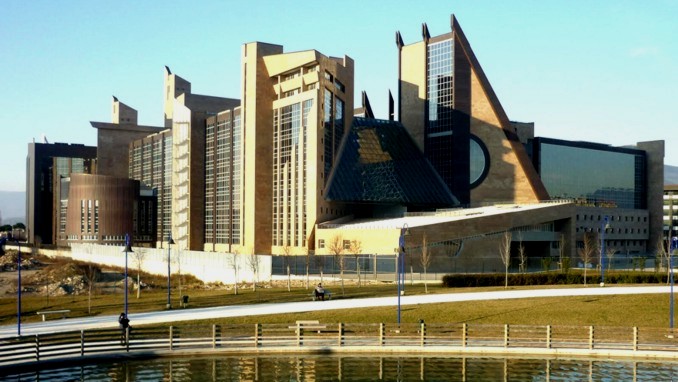
[Click above for a larger image]
The huge new Palace of Justice in north-west Florence was fully opened in January 2012.
It was built on the site of a former FIAT factory. It is Italy’s second largest Palace of Justice after that in Turin (in Rome the justice functions are still distributed) and one of the most modern and spectacular in Europe.
Several thousand people work in the building, including the judges, lawyers, clerks, police and support employees.
It houses all the civil and criminal courts for Florence, and the higher courts for the province of Tuscany. Also the chambers of the chief justice and all other judges. Also the office of the prosecutor general and chief prosecutor and all prosecutors. Also the office of the judges for preliminary investigations (GIP), and also all the associated police and support functions.
It was inaugurated on 23 January 2012 by the Minister of Justice Dr Paola Severino and the Mayor of Florence Mr Matteo Renzi (images below) and It frees up nine sites in the center of Florence for other business.
It was designed by the architect Leonardo Ricci (now deceased), is 240 meters long and 146 wide, with a tower of 72 meters, the second highest in the city. The occupied building area is about 800,000 square meters.
The largest courts are on the ground floor, and the upper floors house smaller courts and the offices for all the judges and prosecutors.

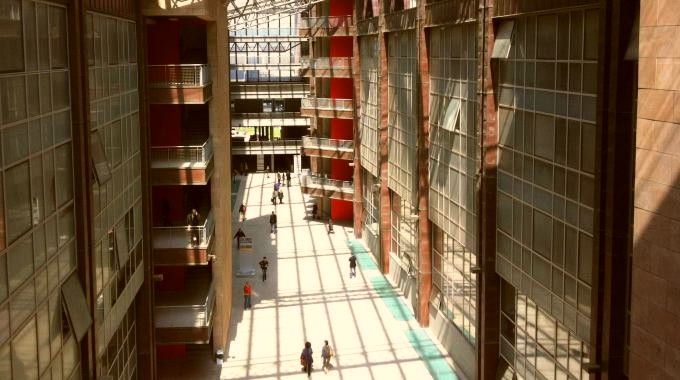
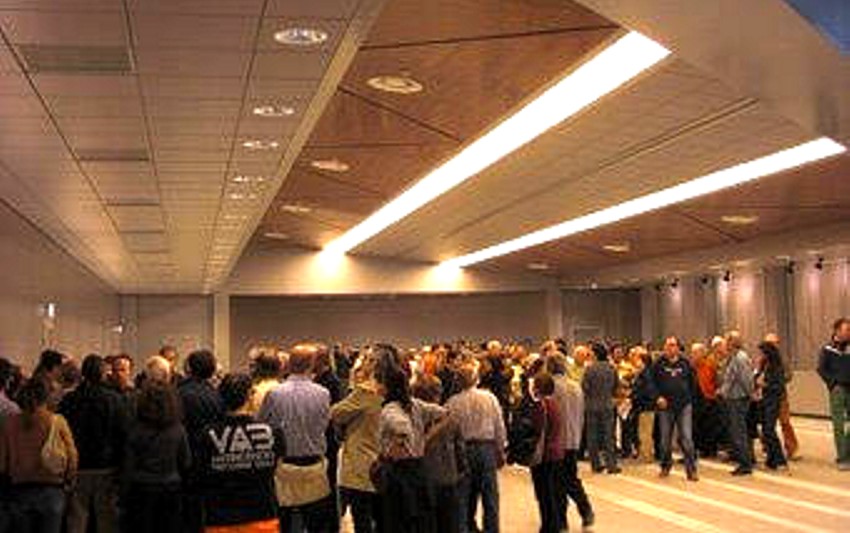
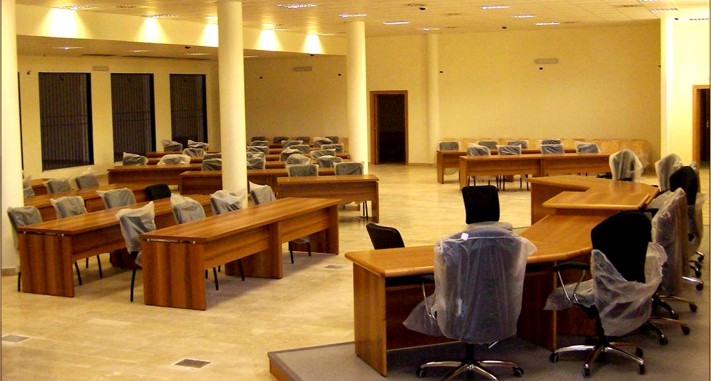

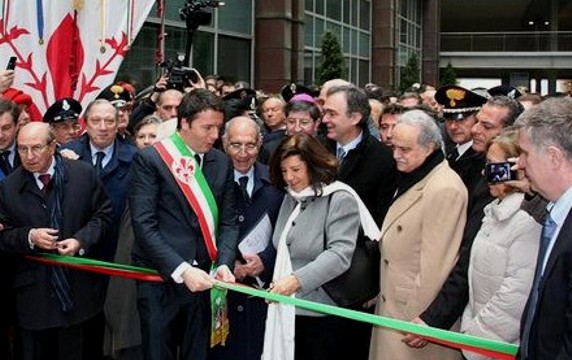
Above: the January 2012 inaugural opening ceremony. Front from the extreme left the Chief Prosecutor (red tie), the Mayor of Florence (red, white and green sash), the Central Government Minister of Justice (white scarf) and the Chief Judge (beige coat).
The Chief Prosecutor Dr Giuseppe Quatrrocchi and the Chief Judge Dr Fabio Massimo Drago will be ultimate overseers of the new appeal. They will appoint the prosecutors and judges who will preside.
The Chief Prosecutor is already heading a contempt of court investigation into the many false claims of criminal behavior in Sollecito’s book. He seems certain to need to do the same if Knox’s book transgresses.
False claims in either book may incur additional years in prison, and millions in civil damages.
Wednesday, April 03, 2013
The Real Catastrophe For The Defenses That Was The Chieffi Supreme Court Ruling
Posted by Machiavelli
1. Overview
On Tuesday March 26, nine judges of the Rome Supreme Court of Cassation led by the respected Dr Chieffi quashed the previous acquittals of Amanda Knox and Raffaele Sollecito for the murder of Meredith Kercher.
The Supreme Court annulled almost the entirety of the 2011 Hellmann-Zanetti appeal verdicts, declaring the appeal outcome completely invalid on five of the six charges. The Court only upheld the sixth charge which made definitive Knox’s conviction for calunnia for which she had been sentenced to three years.
Calunnia is the crime of maliciously placing false evidence or testimony against an innocent person, something the Italian Criminal Code considers not as criminal defamation but as a form of obstruction of justice, a more serious offence.
Worse for Knox, the Court annulled a part of the appeal verdict which had dropped the aggravation known as continuance, the aggravation that acknowledges a logical link between the obstruction of justice and the murder charge.
2. First reactions
Once the dust has settled, the defendants and pro-Knox and pro-Sollecito supporters and defences may finally realize how severe a defeat has been dealt to their side.
Most American journalists were completely unprepared for and very surprised at the outcome. But most Italian commenters and a very few others elsewhere considered the outcome quite predictable (the criminologist Roberta Bruzzone for example hinted so in written articles, so did Judge Simonetta Matone, as well as John Kercher in his book, and many others too).
This really is a catastrophe for the defences. A complete annulment of an acquittal verdict is just not frequent at all. They do occasionally occur, though, and this one appeared easily predictable because of the extremely low quality of the appeal verdict report.
For myself I could hardly imagine a survival of the Pratillo Hellmann-Zanetti outcome as being realistic.
I previously posted at length on the Galati-Costagliola recourse (that is an important read if you want to understand all angles of the annulment). I argued there that a Supreme Court acceptance of the verdict would have so jeopardized the Italian jurisprudence precedents on circumstantial evidence that it would have become impossible to convict anyone in Italy at all.
The previous appeal trial obviously violated the Judicial Code as it was based on illegitimate moves such the appointing of new DNA experts for unacceptable reasons. It contained patent violations of jurisprudence such as the unjustified dismissal of Rudy Guede’s verdict on a subset of the circumstantial evidence. Hellmann-Zanetti even “interpreted” the Constitution instead of quoting Constitutional Court jurisprudence.
They omitted a number of pieces of evidence, literally “forgetting” them or dismissing them without providing an argument (they should have, being an appellate trial based on the previous findings and arguments of the lower court). The appeal trial had obvious illogical contradictions on a macro level, such as the contradictory putting together of the conviction for calunnia and the acquittal on the murder charge (ignoring a logical link required by statute without introducing any reason at all).
The Hellmann-Zanetti verdict was also based on an illogical processing of all pieces of evidence (such as the dismissal of Nara Capezzali’s evidence without logical reason, even after calling her “credible,” and that of Quintavalle; and attributing the bloody footprint to Rudy Guede on the basis of some ludicrous reasoning).
The appeal verdict basically ignored the concept of “a contrario” evidence, like concluding that the luminol footprints are probably not in blood but in some other substance and not related to the murder (despite failure to indicate any alternative substance nor any reasonable scenario).
The verdict was also biased with open prejudice in favor of two of the suspects in assuming they would be unlikely to even socialize or hang out together with the third, based on social or racial discrimination (two whites from good-looking families are called “good fellows” while the third is “different”).
Beyond the glaring, major faux pas in procedure, the verdict’s low quality, unlawfulnesses, and hypocrisy in its reasoning tended to be pervasive and obvious through all its paragraphs, and possibly this also could have caused an aura of distrust toward the work of the Hellmann-Zanetti court.
One could assess the strikingly low quality of the appeal verdict especially by comparing it to a sophisticated recourse such as the 100-page Galati-Costagliola Supreme Court appeal. While nobody could anticipate with total certainty the Supreme Court decision between the Galati-Costagliola appeal and the Pratillo Hellmann-Zanetti appeal verdict, to good legal eyes the outcome would be as uncertain as the result of an England versus San Marino football game!
EACH of the eleven single mistakes, plus EACH of the six “method” mistakes pointed out in the Galati-Costagliola recourse could by itself have been a sufficient cause for the annulment of the acquittals.
The redundancy of reasons and remarks by Cassation sheds light on the judgment shortcomings from many different angles, and all the reasons presented for the recourse were certainly assessed by the Supreme Court.
But on the practical side, most probably the Hellmann-Zanetti verdict did not even survive beyond the first mistake. The appeal verdict most likely crumbled completely from the very beginning on reason #1, the illegitimate appointing of new experts by Hellmann-Zanetti to re-examine the DNA.
But even given that the defences’ defeat could be foreseen, I never expected the defeat to pervade to this extent.
I thought the appeal verdict might be quashed entirely and a new appeal would start from scratch. But the Supreme Court went further and decided to “save” only the parts of the verdict that were unfavorable to Knox, and declared her conviction for calunnia definitive.
Meanwhile, the Court accepted the Calati-Costagliola reason #10, and quashed the part that denied a logical link between calunnia and murder.
The Supreme Court thus sends Raffaele Solecito and Amanda Knox back to appeal trial, but this time Amanda Knox will enter the trial as a felony convict with a definitive criminal record, which ““ the Supreme Court hints ““ is to be considered logically linked with the charge of murder.
Moreover, judges in the appeal that will come next in Florence will have to follow the decisions set by the Supreme Court. Since the Supreme Court’s motivations report has not been issued yet, we still don’t know what points exactly Cassazione will make. But we can expect that several arguments used by Pratillo Hellmann-Zanetti that were “needed” to acquit Knox and Sollecito will be now declared illegitimate.
This might mean that we will not see for a second time such faulty reasoning as “Knox’s statement can’t be used as evidence of lying because it is not true.” It may not be possible to dismiss the verdict that found Guede guilty of concurring in murder “with others” from the set of evidence just because it was “weak.” It may not be possible to deduce the time of death based only on declarations of Rudy Guede.
We also may not have a chance to again see an expert declaring that contamination is “likely” on the sole basis that “everything is possible.” We also may not have another judge attributing footprints without talking about any measurements.

The Supreme Court session began on March 25, and it is only a rare event that a Cassazione session extends over into two days.
The first criminal division of the Supreme Court ““ scheduled to decide on this case ““ was a five-judge panel presided over by Dr Severo Chieffi. His name never did sound like a particularly favorable omen for Knox and Sollecito. Dr Chieffi is a 70-year-old judge, known for being the author of a famous 2008 verdict which definitively closed a notorious criminal case (“the first time a Cassazione hearing attracted massive live media attention”), a verdict among the most quoted in jurisprudence which is known as that “on reasonable doubt.”
Dr Chieffi and his nine-judge panel explained reasonable doubt as to be intended as an “a contrario” concept, the concept used to formulate a logical reasonable alternative. That verdict pointed out the concept of “reasonable” and also stressed that the nature of evidence is “logical”. “Reasonable” depends only on the plausibility of alternatives, not on how conclusive or reliable single pieces of circumstantial evidence are, and a piece of evidence does not require any specific “physical” element or conclusive quality.
The rapporteur judge was Dr Piera Maria Severina Caprioglio. The rapporteur judge goes through the papers of the whole trial and summarizes their content to the other panel judges; the rapporteur and the president are the two who physically write the report (it may sound like irony that both judges have the adjective “severe” in their name). I was told Dr Caprioglio was a rather stiff judge, known for her scrupulosity in procedure matters, and she is also a specialist “and hard liner“ about sexual crime (maybe that’s why she was chosen by Dr Chieffi as the one to do the research on this case).
At the Supreme Court there is also an office known as the Office of Procurator General, which has more than 50 magistrates. The Procurator General appoints a magistrate (normally called the “PG”) to study cases and to make arguments on all cases dealt with in Supreme Court sessions. The PG is considered “neutral” in the sense that their office represents no party only the “precedents” of the court. While the rapporteur makes a description of the case, the procurator makes arguments about the recourses submitted by the parties.
At 10:30 am on Monday, Judge Caprioglio begun her 90-minute speech summarizing the case. She detailed legal events that led to the first Massei-Cristiani verdict, and then the appeal trial led by Hellmann-Zanetti and their verdict.
She sounded rather neutral; hers was a sheer summary with no comment attached. Nevertheless, it sounded most ominous for the defences: right from Dr Caprioglio’s speech, in fact, Knox and Sollecito’s attorneys understood that they were going to lose.
This is because Dr Caprioglio devoted half of her rapporteur time or more to detailing Massei’s first degree trial and verdict, explaining the arguments and evidence used by the Massei court. Such attention was itself ominous to the defences.
A main basis of the Pratillo Hellmann-Zanetti verdict is in fact a series of denials about the work of the lower court, in which plenty of evidence was simply ignored or dismissed without dealing with the first degree conclusions; while the strategy of Giulia Bongiorno was to entirely “replace” the details of the evidence set with a self-made narrative, quite unattached to actual trial events, which somewhat “worked” as rhetoric and in the media.
Yet Dr Caprioglio was not yet the biggest problem facing Knox and Sollecito. The defence was about to face a pincer front, because the Procurator General’s offices did not appreciate the appeal verdict at all.
A bomb went off with the speech of Procurator Riello which followed next.
Dr Riello recalled the points of recourse submitted by Galati-Costagliola, which may sound technical or subtle to those unaccustomed to them. Dr Riello endorsed the radical censures made by Galati-Costagliola and made clear his own view in an overview of the whole verdict. His arguments had the subtlety of an anvil.
To summarize, he basically maintained the appeal judges had conducted an appeal trial as if they were idiots, and followed the paths of logic, procedure and law like sailors without a compass.
Seen from the point of view of the Procurator General, their way of conducting the appeal trial itself was like a journey through a dreadful series of unlawful steps, decisions informally taken without deliberation, and arbitrary and unjustified ordinances. The court simply “lost their way.”
In the body of their findings, it seems they understood almost nothing about the evidence ““ in particular about how circumstantial evidence works. They did not deal with the findings and arguments of the first instance court as they should have, as if they didn’t exist, and they trivialized the previous legal material.
In fact Dr Riello sounded almost sarcastic; outraged by the incredibly amateurish work of this appeal court, he tended to detail the merit of questions and was interrupted by the president asking him to stick to the discussion on the table.
At the close of his speech, he called the appeal verdict “a rare concentration of law violation, a monument to illogicality.” He said “the judge of merit lost their way in this trial.” Dr Riello noted “they fragmented, they parceled out the pieces of circumstantial evidence.”
He implied not only incompetence but a kind of disingenuous attitude: “The Court employed a fair dose of snobbism for trivializing the first degree verdict, reducing it to four elements. A very imprecise and superficial synthesis.”
He went beyond the criticism expressed in the Galati-Costagliola appeal when he described an obvious bias of the appeal court “not in just a few passages of the second instance verdict ““ it’s as if the defendants should benefit from a kind of anthropological and cultural immunity, in relation to the events.”
He criticized Pratillo Hellmann’s dismissal of Amanda Knox’s handwritten memoir, and recommended that a new appeal trial must in part be based on that statement as “it is a usable document”; and he stressed that in his opinion “the scream heard by Amanda is a significant datum, of great importance.” The behavior claimed by Knox on the morning of November 2, 2007 in his view was “chilling” and her taking a shower in a cold bathroom is a “chilling detail.”
Dr Riello concludes by saying: “These are all conditions for not letting the curtains close on an upsetting and extremely serious crime for which the only culprit found up to the present day is Rudy Hermann Guede, who has been addressed through a Lombroso-style assessment, either calling him a thief, a criminal or a drifter. He didn’t confess and he was not convicted by another court for concurring in a crime together with others, maybe with ‘ectoplasms.’” (A reference to Cassation’s previous decision that he did commit the crime with others, but Hellmann-Zanetti identified no other people; hence ‘ectoplasms.’)
The Prosecutor General also dealt with the DNA experts’ report which defined the previous results as “unreliable.” He implied that the report and its language were used as a pretext by the defences “as a tombstone, while in fact it is not.” It was used as a tool to focus the trial on the DNA and steer it away from the whole evidence set, to “bury the set of pieces of circumstantial evidence which all have their vital value.”
The rhetoric of the defences aimed to “blame everything on those involved in the scientific police who are almost depicted as bunglers; however they are not brigadiers playing with toy chemical sets, they are in fact a highly qualified department and they do employ cutting-edge technologies.”
A severe legal bashing like the Riello speech is not at all common at the Cassazione. As I heard the news on the radio, law experts commented that the event was unusually serious, and they hinted that its consequences may lead to the setting of a historic jurisprudence precedent.
Francesco Maresca ““ who brought his mentor Vieri Fabiani with him ““ endorsed the recourse points and made points similar to Dr Riello’s. He pointed out that a major flaw of the appeal trial was to focus on two DNA instances as if the case was based on them. The court appointed experts to review items with no legitimate basis, they provided an inconsistent explanation for their steps, and then they refused to analyze and introduce further evidence, totally contradicting themselves and also violating the code.
Their criteria for choosing which piece of evidence to discuss or review were totally contradictory, and their series of steps egregiously violated a series of procedural conditions that any court is supposed to follow.
The analyzing of the knife DNA sample and bra clasp sample as pieces in isolation is a sort of device that serves a defence made-up narrative; the focus on “disputed” items and the re-make of a narrative about legal events is simply a defence strategy which is aimed at the media rather than official court proceedings. For the Kercher family, the evidence points to the guilt of Knox and Sollecito beyond reasonable doubt.
The evidence, explained Maresca, consisted of numerous pieces of evidence and reasoning, that were simply not dealt with by the appeal court. The whole process was “non-transparent” and the result is also contradictory given that Knox is indicted by her own words on the crime of calunnia.
Maresca explained that the appeal verdict is riddled with many flaws and errors in the merit of the facts which cannot be assessed by the Cassazione court, but there are also patent violations of law which are “strong and obvious” and of the most serious kind.
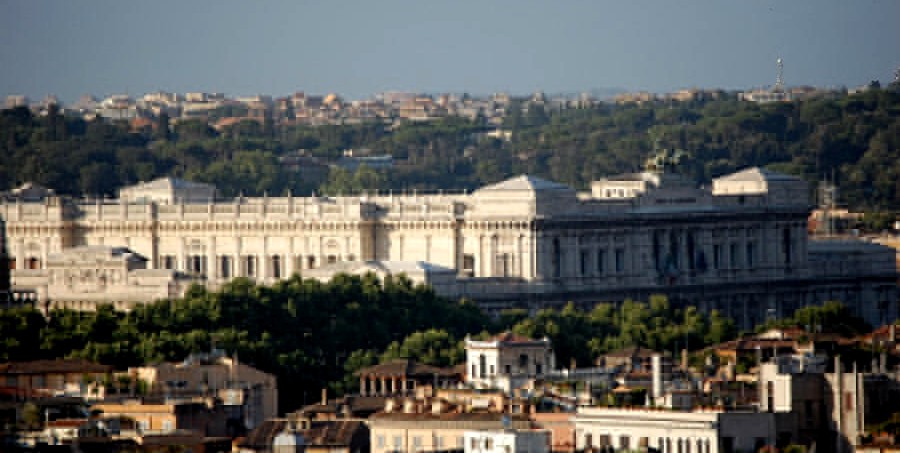
Then it was the defence attorneys’ turn. Giulia Bongiorno knew she would need to apply the full power of her best rhetorical skills: she pointed out a factual error in the recalling of Prosecutor Riello and threw herself head-first into the merit of the evidence.
She even made FOA-style overstatements on the number of Guede’s DNA instances: “So many genetic traces of Rudy Guede were found in the bedroom of the murder, Amanda and Raffaele’s DNA would have been found too if they had been there.” (Her claim is false: in fact, only four samples yielding Guede’s DNA were found in the bedroom, and some were very scant.)
Bongiorno focused on investigation mistakes and complained that Raffaele Sollecito “was put in jail because of a shoe print found beyond the duvet which covered the body, a print that was attributed to Guede.” She also commented on Knox’s handwritten memoir and again put forward the claim ““ already rejected by all the judges of all instances ““ that the statement should be “not usable” because there was a “blackout” of defendant guarantees. Apparently, Bongiorno did understand that the most dangerous threat, and the actual battleground, would be about the danger of having Knox now definitively convicted for calunnia.
Bongiorno said “we do not want to put the scientific police on trial” but then said the point defence demonstrated was that they made “an infinite series of errors.” In fact, Bongiorno’s speech largely consisted of the well-known defense stance of pointing the finger at a list of supposed wrong-doings by the police.
Bongiorno’s argument of pointing out supposed “police mistakes” would probably ring true to Knox’s Amarican supporters, who may find these arguments convincing and effective.
In fact, it was obvious that Bongiorno’s position was extremely weak, and that her arguments were not going to have any effect. The weakness of Bongiorno’s arguments was obvious from the start because she backed into arguing the case only on the merit of investigation techniques.
Her arguments would maybe resonate effectively with uninformed spectators, but they had already failed in those courts that were legitimate, and they have no consequence from a legal standpoint. Talking about supposed mistakes during the investigation and supposed bad behavior of police are good to build a narrative for journalists, but they would have zero effect on expert judges.
I think she knew she was going to lose, but besides being a lawyer, Giulia Bongiorno is also a smart public person, and she plays in the public arena as well as in a court of law at the same time. Her technical stances are all wrong, but she knows she will be remembered well for her good-looking performance.
The president did not interrupt her, showing due politeness toward the defence attorneys. But no attorney would convince the Supreme Court by simply saying “we demonstrated that the investigators made mistakes.”
In order to seek to obtain some positive effect, she should have argued in favor of the Pratillo Hellmann-Zanetti appeal verdict on points of law, and put forward arguments for their legitimacy; for example, an argument in response to point #1 of Galati’s recourse claiming that the appointing of DNA experts was unmotivated.
Luciano Ghirga and Carlo Dalla Vedova had to take care of their own recourse against the conviction for calunnia on the false accusation of Patrick Lumumba. Their line of defence on this point was the same ““ and could be nothing else ““ than what they maintained though all the previous instances. Dalla Vedova deals with the handwritten note where he understands “Amanda says she is confused, she does not care about what she said.”
They reintroduced the myth that “she had been interrogated by the investigators for 54 hours.” They explain ““ almost a paradoxical argument ““ that the document was “a defensive paper” while then becoming one of the elements on which the charge of calunnia was built. They stressed that “she wanted to cooperate” with the investigation and that “she was a friend of Meredith.”
A failure of their arguments was easily predictable because their recourse was built on points that had already failed at lower instances. Some time ago before this appeal, I posted this criticism of the Ghirga-Dalla Vedova recourse on Knox’s calunnia conviction to the Supreme Court:
Pages 3-11: The first argument is about the non-usability of the evidence for the crime of calunnia.
Such an argument is basically the re-proposal of the same argument that had been already dismissed by the Supreme Court in 2008, and subsequently by Massei-Cristiani in 2009 and also by Pratillo Hellmann-Zanetti. Therefore, it is an especially weak argument. Ghirga-Dalla Vedova do attempt to use it again at the Supreme Court because it is what they have.
Just like Giulia Bongiorno will likely recall it too, just like she attempted to request of nullification of Stefanoni’s testimony on procedure grounds before Massei, which was rejected again by Hellmann-Zanetti (the Knox supporters have such a spun perception of the proceedings, they apparently don’t see how some basic defensive claims were rejected by all judges).
Pages 11-14 complete the first argument, addressing the further requirements of the crime of calunnia (maliciousness and voluntarity).
Basically, this point contends that the false accusation was not voluntary or not malicious. The only usable point in my opinion in this reasoning consists of one line, which recalls that Hellmann-Zanetti did not acknowledge the aggravation of continuance for the crime of calunnia. But this point has no consequence because it is a weak point in Hellmann’s verdict itself which violates jurisprudence and logic itself.
The other claims at this point are basically useless; they attack the Hellmann verdict in a way peculiar to the prosecution appeal with an opposite stance. But in fact “not knowing” that someone is factually innocent obviously cannot be extended to an absolute meaning; Hellmann is illogical on that, because he dismisses the logical link with the murder without explanation.
Pages 14-18 speak about the alleged “extreme exhaustion” of Knox in order to exculpate her of her confusion and falsehood.
This argument tends to be a stronger attempt to use some of the contradiction in Pratillo Hellmann-Zanetti, using as a starting point the fact that H-Z did state that Knox was allegedly under excessive pressure. They convicted her for calunnia nonetheless. I think this argument won’t go too far, for two reasons.
First, because it’s basically on the merits; it quotes the whole writing of Knox and requests the SC to directly re-assess the sincerity of her words, something which the SC are unlikely to do.
Second, because while on the one hand there is a contradiction in H-Z as they accuse her of calunnia but do not use her writings as an evidence of lying on the other crime, and they reject the continuance despite the obvious link between the calunnia and the murder, on the other hand the contradiction addressed by Ghirga is weaker. There was in fact no factual finding about “excessive pressure,” neither in the H-Z appeal trial nor in previous Massei testimonies.
As for jurisprudence, pressure and “psychological alteration” itself is not enough to cause a loss of mental faculties to understand and will. Basically, most crimes are committed in a state of psychological stress or alteration, and people are responsible for themselves notwithstanding. The faculty to understand and will is not a psychological condition; it is something that affects the cognitive and decisional functioning of the brain on more basic functions, and requires a medical assessment.
So there is no way the argument of Ghirga-Dalla Vedova can overturn a conviction for calunnia based on an argument of psychological conditions: they have no basis; and there is no consistent ground to assert “excessive pressure” either.
Pages 19-20 is a very short argument about two articles of the code that Ghirga puts in in relation to a case of defensive rights.
This is an argument I am unable to assess clearly. This point basically claims Knox is somehow protected by the law because of an extension of her rights of defence. I have the feeling this point is wrong, because the boundaries of the right to defend oneself are already fixed and limited by a SC ruling of 2008, and because Article 51 only applies to what she declared as a defendant, but not to what she declared as a witness.
Pages 20-22 is only about the sentencing and not about innocence; it claims that, anyway, even if Amanda is guilty of calunnia, the punishment was too stiff and this severity was not logically motivated by Hellmann. This point is the only that could stand, in my opinion.
After the hearing of March 25 ““ which was the ninth case the Supreme Court panel dealt with that day ““ the panel deliberated for six hours, then adjourned the hearing and scheduled the final decision for the following morning.
The question whether to annul the verdict entirely, or to confirm the calunnia conviction, might have been the cause of some of the extra time needed.
When the Supreme Court has to deal with scheduled cases the relator puts a mark ““ between 1 and 8 ““ indicating the difficulty of the case: 1 is the easiest and 8 is very complex.
Almost all recourses are below 3, while a case like the one on the Narducci investigation a week earlier, involving Mignini, could have been closer to 8. The difficulty of this case is unknown. But because of some sensitive jurisprudence involved and because of the articulation of the recourses, this could have been around 6 or higher.
After retirement of the court, and adjournment to the subsequent day, at 10 am on March 26, the court’s dispositivo was the following:
ENDING THE RESERVATION FROM THE HEARING OF 03-25-2013, [THE COURT] DECIDES AS FOLLOWS: ANNULS THE IMPUGNED VERDICT, LIMITED TO THE CRIMES UNDER CHARGES: A) (INTO WHICH CHARGE C) IS ABSORBED), B), D), E), AND TO THE AGGRAVATING CIRCUMSTANCE UNDER C.P. ART. 61 NO.2 IN RELATION TO CHARGE F), AND REMANDS [THE CASE] TO THE CORTE DI ASSISE DI APPELLO OF FLORENCE FOR A NEW TRIAL. REJECTS THE APPEAL OF AMANDA MARIE KNOX, WHOM IT SENTENCES TO THE PAYMENT OF COURT COSTS AS WELL AS REIMBURSEMENT OF EXPENSES INCURRED IN THE PRESENT PROCEEDINGS BY CIVIL PARTY DIYA LUMUMBA, IN THE AMOUNT OF 4000 (FOUR THOUSAND) EUROS, IN ADDITION TO I.V.A. AND C.P.A., PLUS GENERAL EXPENSES ACCORDING TO LAW.
Thus, Amanda Knox and Raffaele Sollecito are sent back to appeal trial in Florence on all charges related to the rape and murder of Meredith Kercher (a, b, c, d, e). And Knox is definitively declared guilty of the obstruction of justice charge known as calunnia, while the argument denying any logical link between the calunnia and the murder is quashed.
Resources used
The article above draws in part upon a translation into English of news information published by various Italian press sources, which our readers may like to look at directly. A good coverage of the case ““ including Riello’s speech ““ was broadcast by RaiNews 24 and they also have a lot of information on the website. Online updates were provided by Televideo. Commentaries and discussions were hosted on Radio1 - GR Rai. Dr Riello’s comments were reported by Il Fatto Quotidiano and Style.it. There were reports on Libero Italy.it. Also details and chronicles were reported at the end of the day by Il Giornale dell’Umbria. Coverage and the quotes for March 25 were provided by AGI. The dispositivo official document was obtained and published by Andrea Vogt.
Monday, April 01, 2013
Alarm Bells Ignored: Overconfident PR And Lawyers May Have Led To That Shock At Cassation Outcome
Posted by Our Main Posters
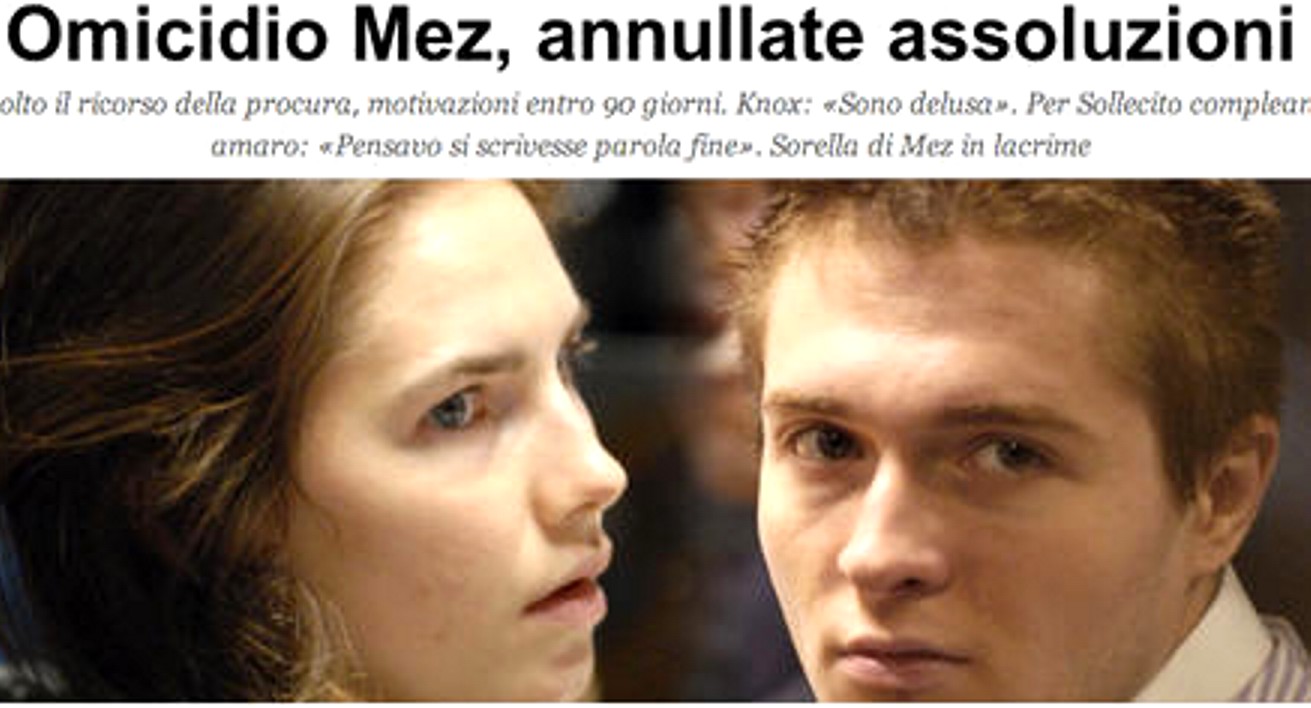
Amanda Knox has seemed to us more stunned than confident since she got out of Capanne. Her father mentioned that she was not given the whole picture there.
But we have been surprised in recent weeks at how the defense lawyers and spokesmen and especially Raffaele Sollecito and Giulia Bongoirno and Carlo Dalla Vedova and the PR flunkies were seemingly seeing the Supreme Court appeal as a forgone conclusion in their favor, a blip requiring no change in the end game.
Here are 20 warning bells that we think they might have missed or heard wrongly which contributed to a shocked and ill-prepared reaction to the Cassation ruling, and each of which a team of hard-nosed lawyers not befuddled by PR might have heard and responded to quite differently.
- 1. The Italian media in 2007-2008 in fact did not blow the case and Knox herself out of all proportion. Most of the lurid headlines appeared in the UK press where they had zero effect on the 2009 jury. There really was a hard case to answer.
2. The British and American media mostly came to be manipulated on the lines Barbie Nadeau’s book described, which meant a big contrast opened up between hard Italian reporting and fantastical UK and US reporting.
3. The Knox and Sollecito teams shrugged off a short-form trial in October 2008 at which point they might have pleaded that Meredith’s murder was not intended and drugs and mental quirks had resulted in a terrible but unintended outcome, perhaps providing relief both for themselves and Meredith’s family.
4. The prosecution part of the trial in 2009 was in fact, contrary to frequent illusory claims, fast and comprehensive and decisive, and it may have been at the end of that phase that the jury was already ready to vote guilty.
5. The defense part of the trial was far less successful with Amanda Knox on the stand suggesting to Italians that she was cold-blooded and uncaring, and from then on the defenses were desultory and dispirited with no strong points ever landed. Several days one or other of them failed to show.
6. The prosecution summation at end of trial was extremely powerful and included in it was a very convincing 15-minute crime-scene recreation video (never released to the public) which accounted for all the marks and stains in Meredith’s room and on her body by an attack group of three.
7. The Massei report, again contrary to frequent illusory claims later, was considered by those familiar with such reports a model of good logic and reasonable assumptions. It laid out and connected hundreds of evidence points which in a normal appeal process would have been unassailable.
8. The 2011 appeal did not happen because Massei was riddled with legal errors and wrong assumptions, which would have been the criteria for any British or American judge to agree to such an appeal. It happened solely because, unique to Italy, such appeals are automatic if demanded, resulting in a huge number of appeals on weak grounds.
9. Italy does not have a terrible record of trial reversals as some claim. It has a record of fine-tuning and adjustments of thousands of appeals by appeal juries seemingly wishing to prove that they are being diligent. Cassation is aware of this quirky systemic effect, and it often bounces back appeal outcomes to dead center.
10. It had appeared that the PR effort was joined by a lot of influential “heavies” including MP Girlanda, Judge Heavey, Senator Cantwell, Joel Simon of CPJ, and the billionaire Donald Trump. Most had limited positive effect in the US and less in Italy, and have been quiet since the Cassation ruling.
11. Judge Hellmann was a surprise replacement for Judge Chiari, then the able and experienced head of the criminal division. (He resigned over this.) Judge Hellmann, a good civil judge, had very limited criminal-case experience. Chief Judge De Nunzio has not explained why he replaced Chiari .
12. The scope of appeals is carefully laid out in the Italian judicial code, and they are not to be repeat trials with overall reconsideration of all evidence and al witnesses only absent the careful presentation process and cross-examination at trial. In the US or UK the defense grounds for appeal might simply have been rejected.
13. Prosecutor Mignini was provisionally convicted in March 2011 of abuse of office, but careful examination would have revealed that the grounds were spurious and he had no need of a conviction in this case. Cassation in the past month has killed his own case terminally and chastized those who brought it.
14. Incriminating DNA was found in Meredith’s room and also outside it in many locations, and also on a knife in Sollecito’s apartment. DNA consultants were “illegally” appointed who muddied the waters but decisively disproved none of it.
15. The Supreme Court is on record as deciding that three perpetrators attacked Meredith. The defenses never set out to prove Guede was a lone wolf attacker, for a long list of reasons, and they failed to prove that jailhouse witnesses Alessi and Aviello had pointed out credible alternatives.
16. The Hellmann-Zanetti report surprised a majority of Italian lawyers who read it for its passion and broad scope and tendentious logic, and for misunderstanding certain key legal concepts. Some instantly saw it as having feet of clay, and a pretty sure candidate for reversal.
17. The significance of Chief Prosecutor Dr Galati in the process seemed seriously discounted. UK and US media mostly ignored his appointment and where he came from, which was in fact Cassation in Rome where he was a highly effective Deputy Chief Prosecutor.
18. The Galati appeal itself was extremely competent and hard line and targeted the Hellmann appeal outcome in several levels or layers in a total of ten points. It is one of the toughest and most sweeping appeals ever filed in Italy, and in the US or UK alarm bells really would have gone off at this one.
19. Sollecito’s book was seemingly okayed by his lawyers, although it causes them major complications in three respects: it introduces new “facts” which contradict his own defense; it derides Italian officials and accuses them of crimes; and it looks like a seedy attempt to make money out of a crime for which the writer is still on trial.
20. While Sollecito had been acting happily oblivious and super-confident in recent months, he has added to Amanda Knox’s own problems by semi selling her out in his book, and by waking the new 800 pound gorilla of contempt of court prosecutions for not respecting the judicial process.
It may not surprise you to learn that Giulia Bongiorno has not had a very winning record at Cassation, and as far as we know the other lawyers have no experience of winning there at all.
Tuesday, March 26, 2013
Tuesday: Elite First Criminal Section Of Italian Supreme Court Annuls The 2011 Appeal Verdict
Posted by Our Main Posters
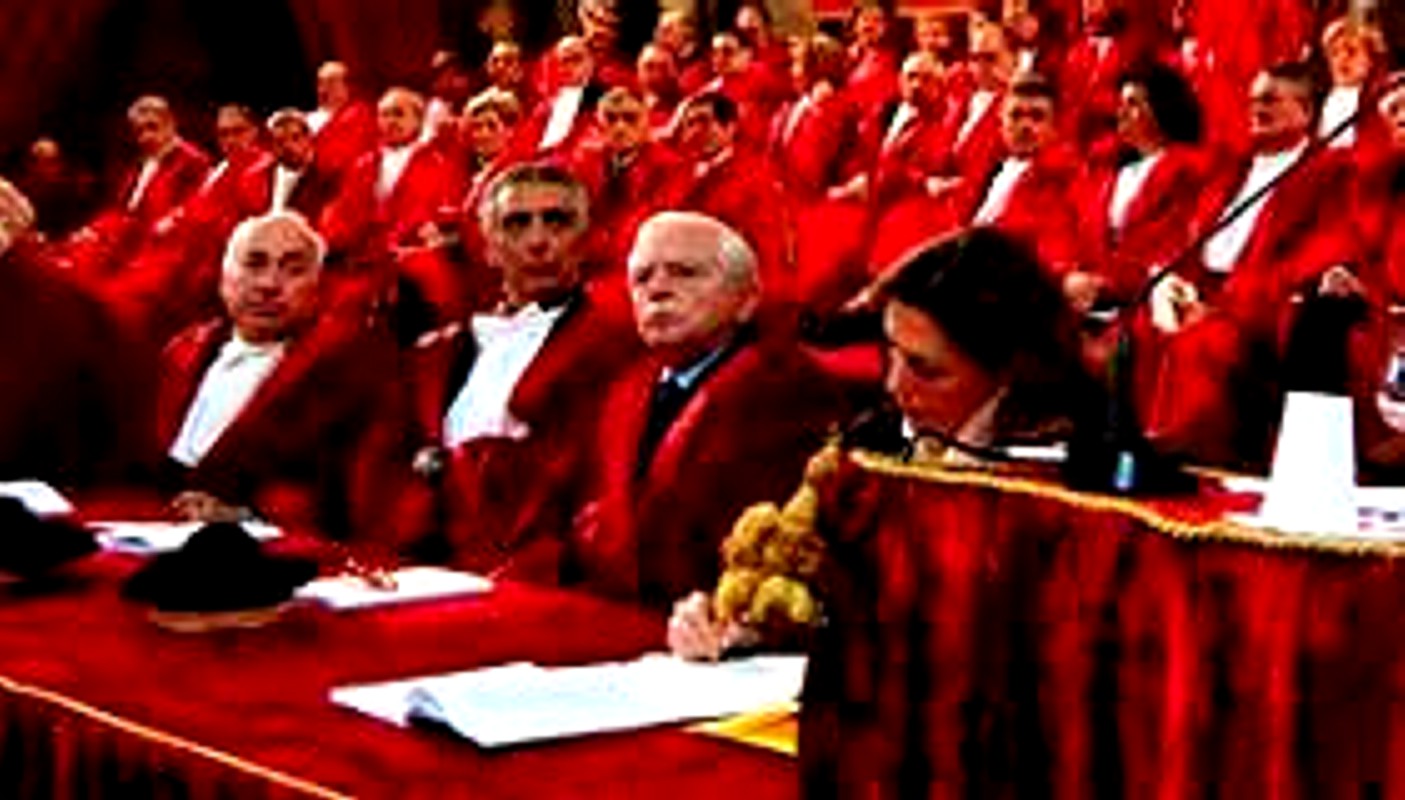
[Above: Some of the judges of the First Criminal Section hearing another recent case, with other sections behind]
Report one
@andreavogt Breaking: high court has anulled acquittals and a retrial has been ordered in #amandaknox case.
Report two
From the New York Times report Italy’s highest court on Tuesday overturned a previous acquittal and ordered a new trial in the sensational case of Amanda Knox, an American exchange student accused of murdering her roommate, Meredith Kercher of Britain, in 2007.
The ruling offered a further dramatic turn in a long-running case that has fascinated many people in the United states, Britain and the rest of Europe. But the full implications of the ruling were unclear, particularly the question of whether Ms. Knox would return voluntarily from the United States or be extradited to face new hearings.
Report three
Andrea Vogt in the Seattle PI. In a stunning turn around of one of Europe’s most closely watched murder trials, Italy’s Court of Cassation on Tuesday annulled the acquittals of Amanda Knox and Raffaele Sollecito and ordered two to stand trial again on appeal.
The decision came after nearly six hours of debate, not just on points of law, but on the evidence too.
This was a rare mix of exceptional violations of law and monumentally illogical reasoning, said Procurator General Luigi Riello in his scathing description of the appeals court’s 2011 decision to acquit. I believe all the elements are there to make sure the final curtain does not drop on this shocking crime, he said.
[Read more, especially on the remarks of AG Riello]
Report four
Further Tweets from Andrea Vogt who was in the courtroom:
Any outcome at appeal retrial in Florence would have to be upheld at Cassation [Rome] level.
No extradition unless formal request is made after a definitive conviction (appeal conviction upheld by high court).
Report five
The news is breaking news on all major U.S. television, including from CNN. The announcement of the Supreme Court arrives at Seattle on the U.S. west coast a little past two in the morning, and in New York at four. “I am not unsatisfied,” said the Attorney General of the Supreme Court Luigi Riello. The lawyer Francesco Maresca, the Kercher family lawyer, welcomed the judgment of annulment by the Supreme Court with a gesture of a fist in victory “It ‘a moral victory and good appeal trial outcome ,” said Maresca. “I had confidence in the Supreme Court” Maresca-explains why there were so many weaknesses of the judgment of the Court of Assizes of Appeal of Perugia.” In tears the victim’s sister, Stephanie said to him. “I’m happy ...,”
Monday, March 25, 2013
Elite First Criminal Section Of Italian Supreme Court Now Receiving Prosecution Critiques
Posted by Peter Quennell

[Above: Some of the judges of the First Criminal Section hearing another recent case, with other sections behind]
We believe the woman in the image is PIERA MARIA SEVERINA CAPRIOGLIO who is the lead judge (rapporteur) for the case.
Dr Caprioglio is known as a legal expert and hardliner on sex crimes. There is a total of five judges, and the president of the First Section is on the panel. This is unprecedented judicial firepower for a murder case, and seems to be a response to the enormous damage done by the Curt Knox/David Marriott campaign. No American political leader is going to second-guess this.
We are anticipating tweets and news reports out of Italy throughout the day. Andrea Vogt is one who is tweeting from the court. Follow her here.
First report:
@andreavogt #amandaknox discussions starting now in cassation court in Rome. Judge Caprioglio is summarizing the case.
Second report
@andreavogt Procuratore Generale Riello now taking the floor in #amandaknox case, after a 90-minute review of all the arguments.
[Deputy Chief Prosecutor Luigi Riello [image below] holds the same rank that Dr Galati held before he transferred to Perugia to be chief prosecutor there.]
Third report
@andreavogt PG Riello: I believe the judges [Hellmann and Zanetti] lost their way. There are elements that were absolutely not taken into consideration.
Fourth report
@andreavogt PG read from Guede’s letter blaming Sollecito and #amandaknox. Says “strange” that court believed some Guede statements and not others.
Fifth report
@andreavogt The president just curtly asked PG Riello to get on with it, not go into details heard already in first instance and appeal.
Sixth report
@andreavogt PG Riello has concluded, asking that acquittals be anulled and an appeal retrial be set. Half hour break in #amandaknox hearing.
Seventh report
Okay this is us. The proposal to annul the Hellmann-Zanetti outcome has gone viral on Italian media websites. A translation of ACP Riello’s remarks is coming.
Eighth report
@andreavogt Cassation back in session in #amandaknox case, w/ Kercher Atty F. Maresca asking why there wasn’t a full review all forensic evidence.
Ninth report
@andreavogt Giulia Bongiorno has begun def arguments in #amandaknox case: “raff sollecito went to jail for a shoeprint that belonged to Rudy Guede.”
Tenth report
@andreavogt #Bongiorno just pointed out a factual error in the PG’s #amandaknox arguments. Judges listening. She’s a very good orator.
Eleventh report
@andreavogt C. Dalla Vedova urges Cassation to uphold #amandaknox acquittals and overturn slander: “This girl was stressed, confused, pressured.”
Twelvth report
@andreavogt Lawyers say the court of cassation is expected to announce a decision in the #amandaknox case around 21:00.
[Image below: Luigi Riello Deputy Chief Prosecutor Of The Supreme Court]
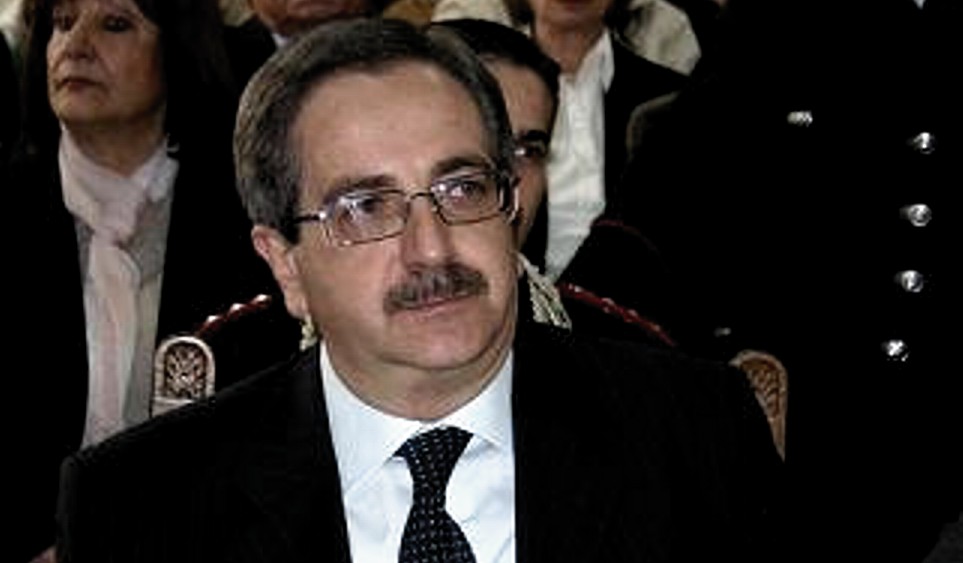
Supreme Court Appeals: A Good Briefing On Tomorow’s Court Proceedings By Italy-Based Andrea Vogt
Posted by Peter Quennell

[Image above: Supreme Court in the foreground and St Peters & Vatican in the background]
Andrea Vogt often tweets very usefully on the case. Her tweet feed is here.
Today’s tweet pointed to this overview here. It is very worth your reading the whole piece.
This is news about three of the judges of Cassation’s elite First Section on Criminal Cases which hasnt yet appeared in the Italian or, UK or US media.
I’ve chosen to not name the magistrates involved in the case until the hearing opens Monday, but for those following closely, here is some brief background on the key judges whose roles are more prominent, based on information I have gleaned from Ministry of Justice documents and “bolletino ufficiale” or public bulletins required to publicly announce personnel changes and events in the judiciary.
The presiding judge is a 72-year old magistrate originally from Naples. Over the years he has dealt with some of Italy’s most high profile crime cases, including the Sarah Scazzi case, as well as the Cassation’s 16-year prison sentence confirmation to Anna Maria Franzoni in the “delitto di Cogne,” the first high-profile case to divide Italy among innocentisti and colpevolisti lines. According to Ministry of Justice documents, the relatrice in the Amanda Knox case is 57-year old female magistrate from Turin.
The procurator general is the figure who has a prosecutor-like function and who presents the case to the panel and suggests what decision should be taken. In this case, the PG is married with two children, has been a judge since 1979 and worked for over two decades in Naples, including several years at the court of appeals there. He is known for his hard line against the clans of the Camorra.
Dr. Giovanni Galati, the Perugia procurator-general leading the recourse of the appeal’s court acquittal ruling is also no stranger to high-profile cases, having worked in the 1980s on the case of Roberto Calvi, the Italian banker murdered and found hanging from Blackfriars Bridge in London in June, 1982
And this further explains the Cassation decision last week which will probably see the hapless Mario Spezi back in prison. We have several more of our own posts pending on this very complex affair.
There was a major development in that case earlier this week, when a separate section of the Cassation court ruled that the decades- old Narducci case, which Mignini had been ridiculed for pursuing, be sensationally re-opened.
The ruling gives new credence to Mignini’s much-maligned theory that there had been a body swap and cover up in the death of the Perugia doctor found in Lake Trasimeno and alleged to be involved in the Monster of Florence case.
Mario Spezi is among those whose acquittals were overturned this week and who has been called by the high court to stand trial. Spezi’s alleged crime is calunnia, for suggesting Antonio Vinci was the real killer (his book marries this theory and it is the charge over which he was originally taken into custody in 2006). It appears there are still a few chapters to be written.
Spezi has one definitive defamation conviction from the 1980s, and in the last two years, courts in Perugia and Florence handed down other convictions. He also faces trials in Padua, Milan and Perugia: all related to allegedly false or defamatory declarations in the Monster of Florence case.

